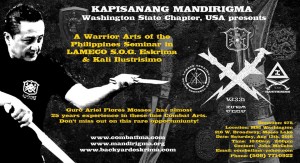
Guro Ariel Flores Mosses Lameco and Ilustrisino Eskrima Seminar. Moses Lake, Washington. … [Read more...]
Mandirigma Research Organization

Guro Ariel Flores Mosses Lameco and Ilustrisino Eskrima Seminar. Moses Lake, Washington. … [Read more...]
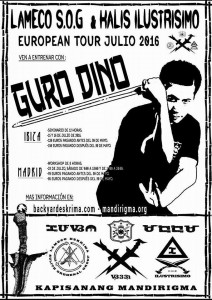
Seminar: Lameco S.O.G. & Kali Ilustrisimo European Tour 2016 with Guro Dino Flores https://www.facebook.com/LAMECOESKRIMAKALISILUSTRISIMO/timeline https://vimeo.com/170345485 https://youtu.be/f-7qJgs418I Seminar Spain Video 2 Lameco S.O.G. & Kali Ilustrisimo European Tour Come train with one of Lameco S.O.G´s and Kali Ilustrisimo´s most combat oriented Instructors. Lameco S.O.G. & Kali Ilustrisimo European Tour – July 2016 Come train with one of Lameco S.O.G´s and Kali Ilustrisimo´s most combat oriented Instructors – Guro Dino Flores! Guro Dino has almost 25 years of experience with Lameco Eskrima and Kali Ilustrisimo. Guro Dino was one of Punong Guro Edgar Sulite favorite fighters from the Infamous Lameco Backyard Group. In the Lameco Backyard, fancy drills were always secondary – various degrees of sparring intensity always came first. He was personally trained by Punong Guro to be a fighter above all else. Even accepting challenges on Punong Guro Sulite’s behalf. He is also is an Authorized Instructor under Grandmaster Christopher Ricketts and Grandmaster Antonio Diego. During Master Ricketts time in the USA, Guro Dino was one of his assistants. Constantly sparring people at Master Ricketts request. He has also had the good fortune to train with all Five Pillars of Ilustrisimo and was one of the few members of the notorious LAMECO S.O.G. He is currently the director and an Instructor of the Kapisanang Mandirigma Institute founded by members of Lameco S.O.G. Join us in Madrid and Ibiza. Guro Dino will be taking it a high level of intensity. As an option only – for those who want to take full advantage of this combat oriented training, bring you sparring gear. To add to the excitement, Guro Dino will also be accompanied by two of his most skilled fighters – Brett Granstaff and Mark Ramos. Find out for yourself why Lameco S.O.G. and Kali Ilustrisimo is respected in the Martial Art World. More information about Guro Dino Flores at this link: http://backyardeskrima.com/?page_id=52 Guro Dino Flores will be conducting Action Packed seminars in IBIZA AND MADRID. Guro Dino is only in Europe periodically. Don’t miss this very rare opportunity!!! IBIZA Seminar 12 hours 15th and 16th , OF JULY 2016 120 Euros if paid before May 30th 150 Euros after May 30th MADRID Workshop 8 hours 23 RD OF JULY Saturday From 9:00 am to 13:00 and from 16:00 to 20:00 pm. 70 Euros if paid before May 30th, 2016 85 Euros after May 30th Special prices for groups. For more information – Contact Guro Dino’s LAMECO S.O.G and Kali Ilustrisimo Representative in Spain, Tim Fredianelli: fredianellibruno@gmail.com More Seminar Information at: http://backyardeskrima.com/?p=1813 and http://mandirigma.org/?p=2957 … [Read more...]
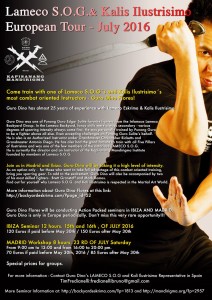
Lameco S.O.G. & Kali Ilustrisimo European Tour Come train with one of Lameco S.O.G´s and Kali Ilustrisimo´s most combat oriented Instructors. Lameco S.O.G. & Kali Ilustrisimo European Tour - July 2016 Come train with one of Lameco S.O.G´s and Kali Ilustrisimo´s most combat oriented Instructors - Guro Dino Flores! Guro Dino has almost 25 years of experience with Lameco Eskrima and Kali Ilustrisimo. Guro Dino was one of Punong Guro Edgar Sulite favorite fighters from the Infamous Lameco Backyard Group. In the Lameco Backyard, fancy drills were always secondary - various degrees of sparring intensity always came first. He was personally trained by Punong Guro to be a fighter above all else. Even accepting challenges on Punong Guro Sulite’s behalf. He is also is an Authorized Instructor under Grandmaster Christopher Ricketts and Grandmaster Antonio Diego. During Master Ricketts time in the USA, Guro Dino was one of his assistants. Constantly sparring people at Master Ricketts request. He has also had the good fortune to train with all Five Pillars of Ilustrisimo and was one of the few members of the notorious LAMECO S.O.G. He is currently the director and an Instructor of the Kapisanang Mandirigma Institute founded by members of Lameco S.O.G. Join us in Madrid and Ibiza. Guro Dino will be taking it a high level of intensity. As an option only - for those who want to take full advantage of this combat oriented training, bring you sparring gear. To add to the excitement, Guro Dino will also be accompanied by two of his most skilled fighters - Brett Granstaff and Mark Ramos. Find out for yourself why Lameco S.O.G. and Kali Ilustrisimo is respected in the Martial Art World. More information about Guro Dino Flores at this link: http://backyardeskrima.com/?page_id=52 Guro Dino Flores will be conducting Action Packed seminars in IBIZA AND MADRID. Guro Dino is only in Europe periodically. Don’t miss this very rare opportunity!!! IBIZA Seminar 12 hours 15th and 16th , OF JULY 2016 120 Euros if paid before May 30th 150 Euros after May 30th MADRID Workshop 8 hours 23 RD OF JULY Saturday From 9:00 am to 13:00 and from 16:00 to 20:00 pm. 70 Euros if paid before May 30th, 2016 85 Euros after May 30th Special prices for groups. For more information - Contact Guro Dino’s LAMECO S.O.G and Kali Ilustrisimo Representative in Spain, Tim Fredianelli: fredianellibruno@gmail.com More Seminar Information at: http://backyardeskrima.com/?p=1813 and http://mandirigma.org/?p=2957 … [Read more...]
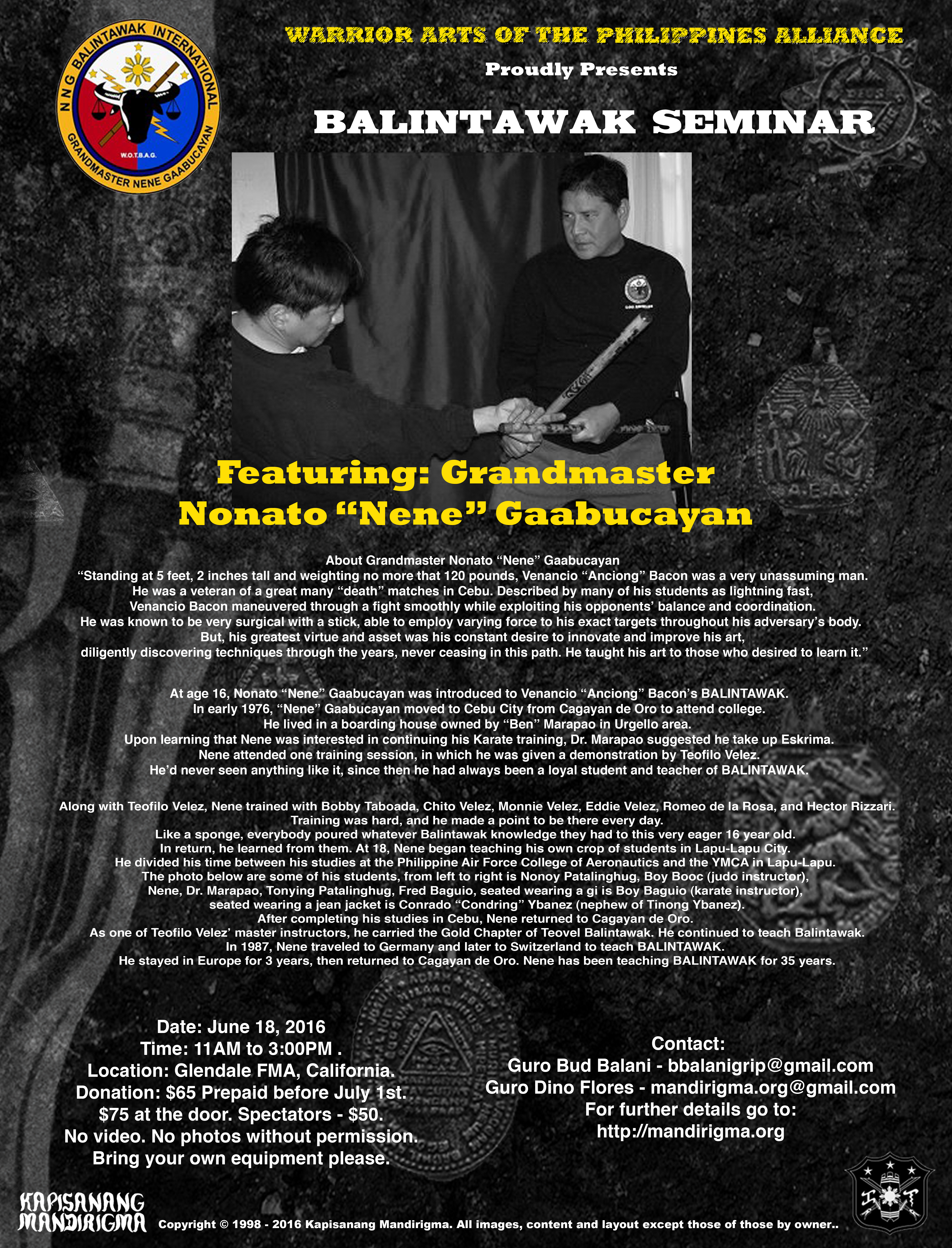
Grandmaster Nonato “Nene” Gaabucayan Balintawak Seminar About Grandmaster Nonato “Nene” Gaabucayan “Standing at 5 feet, 2 inches tall and weighting no more that 120 pounds, Venancio “Anciong” Baconwas a very unassuming man. He was a veteran of a great many “death” matches in Cebu. Described by many of his students as lightning fast, Venancio Bacon maneuvered through a fight smoothly while exploiting his opponents’ balance and coordination. He was known to be very surgical with a stick, able to employ varying force to his exact targets throughout his adversary’s body. But, his greatest virtue and asset was his constant desire to innovate and improve his art, diligently discovering techniques through the years, never ceasing in this path. He taught his art to those who desired to learn it.” At age 16, Nonato “Nene” Gaabucayan was introduced to Venancio “Anciong” Bacon’s BALINTAWAK. In early 1976, “Nene” Gaabucayan moved to Cebu City from Cagayan de Oro to attend college. He lived in a boarding house owned by “Ben” Marapao in Urgello area. Upon learning that Nene was interested in continuing his Karate training, Dr. Marapao suggested he take up Eskrima. Nene attended one training session, in which he was given a demonstration by Teofilo Velez. He’d never seen anything like it, since then he had always been a loyal student and teacher of BALINTAWAK. Along with Teofilo Velez, Nene trained with Bobby Taboada, Chito Velez, Monnie Velez, Eddie Velez, Romeo de la Rosa, and Hector Rizzari. Training was hard, and he made a point to be there every day. Like a sponge, everybody poured whatever Balintawak knowledge they had to this very eager 16 year old. In return, he learned from them. At 18, Nene began teaching his own crop of students in Lapu-Lapu City. He divided his time between his studies at the Philippine Air Force College of Aeronautics and the YMCA in Lapu-Lapu. After completing his studies in Cebu, Nene returned to Cagayan de Oro. As one of Teofilo Velez’ master instructors, he carried the Gold Chapter of Teovel Balintawak. He continued to teach Balintawak. In 1987, Nene traveled to Germany and later to Switzerland to teach BALINTAWAK. He stayed in Europe for 3 years, then returned to Cagayan de Oro. Nene has been teaching BALINTAWAK for 35 years. For more information: https://www.facebook.com/groups/367399160092901/ … [Read more...]
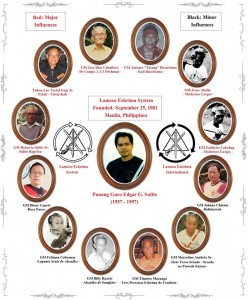
Punong Guro Edgar Sulites Influences in creating Lameco Eskrima. Courtesy of Guro Dave Gould. Below is a poster which I placed together showing the Major and Minor Influences which Punong Guro Edgar G. Sulite credited for his knowledge and for the creation of the Lameco Eskrima System. In essence these Grandmasters, their systems and knowledge were responsible for the Lameco Eskrima System that we know and train today. In addition to the numerous actual experiences which PG Sulite drew from and the thousands of hours of sparring and fighting with his two primary sparring partners, Master Christopher N. Ricketts and Master Jun Pueblos.The Major Influences were from Masters and Systems which PG Edgar G. Sulite thoroughly trained under for years and was certified to teach their respective styles. The Minor Systems were from Masters with whom PG Edgar G. Sulite trained to some degree and with whom he collaborated but never received ranking in their respective Systems. 5 Major Influences on the Lameco Eskrima System: * De Campo Uno-Dos-Tres Orihinal (GM Jose D. Caballero) * Kali Illustrisimo (GM Antonio “Tatang” Illustrisimo) * Kali Pekiti-Tirsia (Tuhon Leo Tortal Gaje Jr.) * Modernos Largos (GM Jesus Abella & GM Pablicito “Pabling” Cabahug) * Sulite Rapelon (GM Helacrio Sulite Sr.) 6 Minor Influences on the Lameco Eskrima System: * Doce Pares (GM Diony Canete) * Balintawak (GM Johnny Chiuten) * Lapunti Arnis De Abanico (GM Felimon E. Caburnay) * Siete Teros Serado – Serado no Puwede Entra (GM Marcelino Ancheta Sr.) * Abanico De Sungkiti (GM Billy Baaclo) * Tres Personas Eskrima De Combate (GM Maj. Timoteo E. Maranga) … [Read more...]
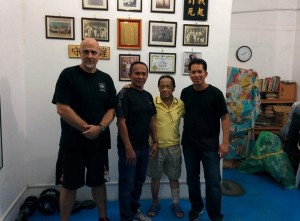
Alexander Lim Co Alexander Lim Co is a living treasure in the arts of Chinese kung-fu. In fact, no name is more synonymous with Kung-Fu in the Philippines than Alexander Co. He spearheaded the Chin Wu Club in Manila, wrote the first kung-fu book ever published in the Philippines, and published the country’s first martial arts magazine, simply titled “Martial Arts Magazine.” Co has studied a dozen different kung-fu styles, was an “in-door” disciple of Ngo Cho Kun’s late grandmaster Tan Ka Hong, and has studied Seven Star Praying Mantis and Hung-gar under Grandmaster Shakespeare Chan, Wu style Tai Chi Chuan under the late Master John Hu Chuan Hai, and Hsin-I Liu Ha Pa Fa under Master David Chan. Alexander Co is the Advising Grandmaster of The International Beng Hong Athletic Association. He has served as Chairman of the Philippine-Chinese Beng Kiam Athletic Association and the Tsing Hua Ngo Cho Kung-fu Center and as Vice-chairman of the Hsin-I Society of Internal Arts. In addition to dozens of articles featured in such magazines as Martial Arts Magazine, Rapid Journal, Inside Kung-Fu, Martial Arts Illustrated, and Martial Arts Legends. Grandmaster Co has written three books: Secrets of Seven Star Praying Mantis, The Way of Ngo Cho Kun and Five Ancestor Fist Kung-Fu, and is translator of The Bible of Ngo Cho Kun. He also filmed a series of instructional videos “The Essence of Ngo Cho Kun” and “The Essence of Seven Star Praying Mantis” for Unique Publications Video. --- Ronnie Ricketts I was saddened to hear of the passing of a good friend and a great master, Alex Co . He was an amazing influence in the lives of our Bakbakan brothers. Our sincerest condolences to the family and may you rest in peace, Master Alex! Lance Velez The loss of Master Alex is a loss to the world of martial arts. He knew so much and shared his knowledge with those who showed Interest, with no reservation , he was a true master of his art and I am sad that I wasn't able to spend more time with him... It hurts that I no longer have his counsel and insight when I have questions the thought that we will no longer have our conversations is heartbreaking. I will do my best to maintain and master what you taught me so in my own small way I can preserve the art of Ngo Cho ... Rest in peace Master Alex ... I will miss you ... Mark Wiley It is with a heavy heart that I mourn the passing of one of my best friends, big brother and kung-fu master, Sifu Alex Co. He passed at 10:34 PM Manila time, April 12, 2016. His kind and loving heart and openness in sharing his passion for all martial arts with all people was unmatched. He is one of the legends of the Philippine martial arts masters, who brought all together from every discipline. He suffered much these past years with heart troubles, kidney failure, diabetes, digital amputation... But his drive to keep documenting and spreading the arts he loved was unstoppable. My son, Alex, is named in his honor and forever I will treasure his memory in my heart. --- It is with a heavy heart that I mourn your passing, Sifu Alex, you are one of my best friends, big brother, father and kung-fu master. Our long relationship is deeply embedded in my heart and I am struggling with not being able to call you and talk or come for a visit. You are among the most important people in my life and I can't imagine my future without you here. Rest in peace. Doran Sordo Master Alex Co was an exceptional human being. He was one of the best friends of my master, Christopher Ricketts. He was very strict when he would be teaching us. Always keen on the details. It was because of Master Topher that I met, got to know, and learned extensively from Master Alex. He was so selfless in his teaching. Breaking from the norm, because of his friendship and trust for Master Topher and the students he would bring by. He was such a kind man. Soft spoken and yet, powerful. I will miss him greatly. He was a cornerstone to our Bakbakan Brotherhood. On one of the last conversations I had with Master Topher, he told me to never stop learning. He mentioned only two people. Master Alex was one of them. Rest in peace, Master. Thank you so much for teaching me. I will never forget it, or you. Paalam Po. Jun Nunez This picture was taken by Grandmaster Topher Rickets of Bakbakan. With me is Grandmaster Edgar Sulite of Lameco Escrima, Master HuTuan Hai of Wu Tai Chi Chuan, and Master Alex Co of Ngo Cho Kun. It's sad to know that I am the only one left with the passing of my friend Alex. Goodbye my friend Felipe P. Jocano Jr. With deep sorrow, I mourn the passing of my kung-fu teacher and friend, Sifu Alexander L.co. He was one of the kindest, most generous and caring men I have had the privilege of meeting and learning from. He not only taught martial arts, he was also an example of the true martial arts … [Read more...]
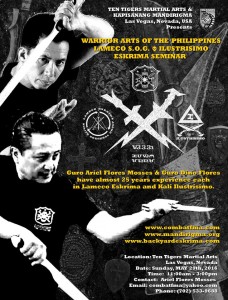
Seminar: Lameco SOG Eskrima and Kali Ilustrisimo with Guro Ariel Flores Mosses and Guro Dino Flores. Las Vegas, Nevada. May 29th, 2016. https://vimeo.com/163357215 https://vimeo.com/163357215 … [Read more...]
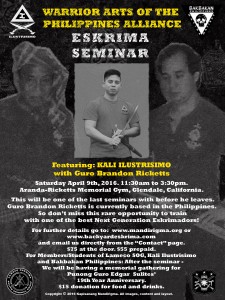
Seminar: Kali Ilustrisimo with Guro Brandon Ricketts. Glendale FMA, California. April 9th, 2016. … [Read more...]
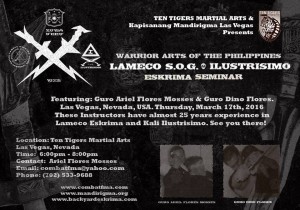
Seminar: Lameco SOG and Kali Ilustrisimo with Guro Dino Flores Guro and Ariel Flores Mosses. March 17th, 2016. Las Vegas. … [Read more...]

Kali Ilustrisimo: The Sword Fighting Art of Antonio Ilustrisimo By Master Christopher Ricketts, Guro Bruce Ricketts, Guro Brandon Ricketts http://www.blurb.com/b/6612146-kali-ilustrisimo-the-sword-fighting-art-of-antonio ABOUT THE BOOK With over 3 decades of intensive training in both Filipino & Chinese disciplines, Christopher Ricketts presents Kali Ilustrisimo as it was taught to him by the now legendary swordsman, Antonio Ilustrisimo. Grandmaster Ricketts brings his insight to this highly regarded fighting art with clarity and precise methodology that is sure to enrich any student regardless of style or system. Lavishly illustrated with diagrams and pictures from Grandmaster Rickett's personal and comprehensive archives, experts and beginners alike stand to benefit greatly from this presentation. Catch a rare glimpse into the inner workings of this uniquely Filipino fighting system. The art and legacy of Antonio Ilustrisimo lives on. Author websitehttps://www.facebook.com/IlustrisimoUSA … [Read more...]
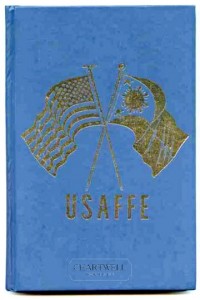
USAFFE by Poweleit, Alvin C., M.D., Major, U.S. Army Medical Corps (Ret.) (Author) USAFFE, the loyal Americans and faithful Filipinos: A saga of atrocities perpetrated during the fall of the Philippines, the Bataan Death March, and Japanese imprisonment and survival Hardcover – 1975 Title USAFFE, the loyal Americans and faithful Filipinos : a saga of atrocities perpetrated during the fall of the Philippines, the Bataan Death March, and Japanese imprisonment and survival / by Alvin C. Poweleit. Subject Poweleit, Alvin C. World War, 1939-1945--Campaigns--Philippines. World War, 1939-1945--Prisoners and prisons, Japanese. World War, 1939-1945--Health aspects. World War, 1939-1945--Personal narratives, American. Description Wartime diary of the American Surgeon of the Provisional Tank Group, from arrival in the Philippines through the battles for the defense of the Philippines, the Death March, prisoner of war experiences and liberation. Poweleit was a reserve officer called to active duty in 1940, and attached to the 192nd Tank Battalion; he arrived in the Philippines less than a month before the war started. He was with the tank men from the start of the war through the surrender of Bataan; imprisoned in Camp O’Donnell, Cabanatuan and other camps, and then moved to Taiwan in September 1944, where he stayed till the end of the war. The book is not a verbatim publication of his diary proper, but has added information taken from post-war sources. He also recounts the other hell ships and the Palawan Massacre. Creator Poweleit, Alvin C. Publisher [s.l.] : Poweleit, c1975 Date 1975 Format 24 x 16 cm. Type Hardbound Call Number D 767.4 .P68 1975 Accession Number 13978 Pagination vii, 182 p. Illustration ill., maps Keywords Poweleit, Alvin C.; World War, 1939-1945--Campaigns--Philippines.; World War, 1939-1945--Health aspects.; World War, 1939-1945--Personal narratives, American.; World War, 1939-1945--Prisoners and prisons, Japanese. Collection Diaries Citation Poweleit, Alvin C., “USAFFE, the loyal Americans and faithful Filipinos : a saga of atrocities perpetrated during the fall of the Philippines, the Bataan Death March, and Japanese imprisonment and survival / by Alvin C. Poweleit.,” FHL - Roderick Hall Collection, accessed January 30, 2016, http://rodhall.filipinaslibrary.org.ph/items/show/933. ----- United States Army Forces in the Far East (USAFFE) was a military formation of the United States Army active from 1941 to 1946. The new command's headquarters was created on July 26, 1941, at No. 1, Calle Victoria, Manila, Luzon, the Philippines, with General Douglas MacArthur as commander. The Chief of Staff was Brigadier General Richard K. Sutherland and the Deputy Chief of Staff was Lieutenant ColonelRichard J. Marshall. The core of this command (including MacArthur, Marshall, and Sutherland) was drawn from the Office of the Military Advisor to the Commonwealth Government. … [Read more...]
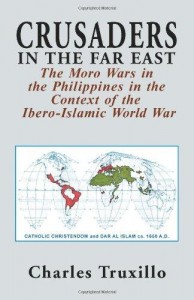
Crusaders in the Far East: The Moro Wars in the Philippines in the Context of the Ibero-Islamic World War By Charles Truxillo Early modern warfare between Spaniards and Muslims for control of the Philippine Islands was set within the context of the larger Iberian offensive against the Islamic world in the sixteenth and early seventeenth centuries. The struggle was on a global scale from the coast of North Africa to the Southern Seas. Moreover, the antiquity of Christian-Muslim wars in Spain and the flood tide of Counter-Reformation Catholic and Sufi-Islamic expansions in the sixteenth century gave special significance to theconvergence of these factors in the Philippines. The contemporary resurgence of Islam and the continuing rebellion of the Moros in the southern Philippines makes this study relevant to modern concerns. This survey will establish the circumstances of the Ibero-Islamic World War in the context of traditional, pre-modern societies on the verge of modernity. Change in the nature of historical action was represented during the sixteenth and seventeenth centuries, not by Spain and Portugal or any Islamic society, but rather by Holland and later England. The Iberian and Islamic participants of the first global conflict will appear to be traditional societies involved in geo-political circumstances beyond their capacities as pre-modern, agrarian-based, citied peoples. The Moro Wars in the Philippines represent the closing of an older world in Island Southeast Asia; the demise of Iberian dreams of an oriental empire, and the halting of a thousand years of hemisphere-wide Islamic expansionism. Modernity was the outcome of the seventeenth century's technical-capitalist revolution which established the enlarged political franchise of Northern Europe. These developments, in turn, were the instruments of European world domination in the nineteenth century. During the twentieth century, modernization has evolved non-Western European forms, spreading to Russia, Eastern Europe, Turkey, India, and the Far East. In contrast, the majority of Hispanic and Islamic societies remain underdeveloped, seemingly transfixed by the accomplishments of the past. The legacy of the Ibero-Islamic World War is still manifest in the charismatic politics, military governments, religious agendas, landed aristocracies, literary educations, patrimonial families, and masculine styles of most Muslim and Latin American societies. … [Read more...]

Books on America and the Moros by Robert A. Fulton http://www.morolandhistory.com/Books_page/Book_Page.htm Released January 15, 2012 The Battle of Bud Dajo took place over three days, March 5-8, 1906. It pitted the U.S. Army. U.S. Navy, and the Philippine Constabulary against 800-1,000 dissident Muslims who had fortified the top of a rugged, 2,175 feet high dormant volcano on the island of Jolo in the southern Philippine Islands. Although beginning as a genuine military contest, it ended as a tragic and terrible, one-sided massacre, with no more than a small and pitiful handful of the Muslims left alive. Although lesser known. It ranks beside such infamous names as "Sand Creek" (1864), "Wounded Knee"(1890), and "My Lai" (1968) as one of the darkest, bloodiest, and most controversial episodes in America's long and troubled history of deadly encounters with indigenous peoples. More than just a straightforward account of an epic fight on a spectacular mountain, it is also the story of a second and equally vicious donnybrook within the nations' press and on the floor of Congress to comprehend what had actually occurred on that remote field of battle and why. At stake were the careers of one the most well known soldiers of the early 20th Century, General Leonard Wood, former commanding officer of the famed Spanish-American War cavalry regiment, the Rough Riders. Also risk was a future President and Chief Justice of the Supreme Court, William Howard Taft, as well as the reputation of one of the country's most popular Presidents, Theodore Roosevelt. But there is also a mystery here. The real story of what happened would remain buried for more than another century. Why? Was there a deliberate, and successful, cover up? If the real facts had come to light sooner, would it have mattered? Could it have impacted the course of American history? Is there a lesson to take away here, or at least a warning? HONOR FOR THE FLAG is based on path finding research into the original files, which was first published in 2007 my book MOROLAND; but it is much broader in scope and not only narrates a reliable account of the battle itself but how it rapidly evolved into a contentious and divisive debate over the moral basis of American intervention in foreign lands. 200 pages, including 72 photographs and illustrations. To see reviews and purchase, click on the web links below: Moroland is the lost history of the once-famed struggle between the United States Army and the "wild" Moros, the Muslims of the southern Philippine islands. Lasting over two decades, it was this country's first sustained encounter with a volatile mixture of nation building, insurgency, counterinsurgency, and militant Islamism. An unanticipated byproduct of the Spanish-American War, the task of subduing and then "civilizing" the "Land of the Moros" was delegated to the U.S. Army. Working through the traditional ruling hierarchy and respecting an ancient system of laws based on the Qur'an, Moro Province became an autonomous, military-governed Islamic colony within a much larger, overwhelmingly Christian territory, the Philippine Islands. An initially successful occupation, it transitioned to a grand experiment: an audacious plan to transform and remake Moro society, values, and culture in an American image; placing the Moros on an uncertain and ill-defined path towards inclusion in an eventual Western-style democracy. But the Moros reacted with obstinate and unyielding resistance to what they perceived as a deliberate attack on the religion of Islam and a way of life ordained by God. This ignited a constant stream of battles and expeditions known in U.S. Army history as the Moro Campaigns and lasting more than a decade. In violence and ferocity they may have equaled, if not surpassed, the more famous late-19th Century Indian Wars of the Great Plains. It also led to the creation of the fabled Moro Constabulary, small contingents of native troops led by American, European, and Filipino officers. The backdrop is a bustling, raucous, newly-prosperous nation finding its way as a world and imperial power. But with this new-found status came a near-religious belief that the active spread of America's institutions, values, and form of government, even when achieved through coercion or force, would create a better world. A subtext is a deep and bitter rivalry between two of its most prominent players, Captain John J. Pershing and General Leonard Wood, born only one month apart, each championing markedly opposed military philosophies. Eventually they would compete to lead one-million American "doughboys" into the cauldron of the world's first Great War. Few Americans are aware that a century later the U.S. military has quietly returned to Moroland, to battle "radical Islamist terrorism"; using Army Green Berets, Navy Seals, and other elite forces. It is the … [Read more...]
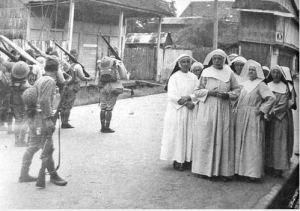
Liberation That Destroyed: The End of Manila, Queen of the Pacific By HECHO AYER: https://hechoayer.wordpress.com/2010/07/29/liberation-that-destroyed-the-end-of-manila-queen-of-the-pacific/ An Insult to Religious Filipinos' Sensibilities: Nuns Being Rounded Up by Japanese Soldiers (http://img51.imageshack.us/i/image005wn.jpg/) With no applause, but with artillery fire, American bombs, Japanese lust and death, Manila, Queen of the Pacific, made her inglorious bow to the world in February 1945. Iconic Photo of an American Tank Forcing Its Entry Into For Santiago, Once Impenetrable (AHC) In a single month, what was built for centuries to being Asia’s first and genuine melting pot was destroyed and forever erased from the world. The capital city of the Philippines became the stage for not only bodily massacre but also, spiritual, cultural, artistic and national eradication. It was in 9 January 1945 when Lt. Gen. Walter Krueger arrived in Lingayen Gulf, Pangasinan in what would become a United States campaign to recapture the Philippines from Japanese claws. By the end of January, much progress has been made by the Americans in reaching the outskirts of Manila namely that of Tagaytay and Nasugbu. They began to make their way up north to Manila. American Tank Inspects Intramuros' Ruins. Notice the Walls of Sto. Domingo (AHC) Backside of Once Marvelous Sto. Domingo Church (AHC) The Manila Post Office (Where my Great Grandfather was Post Master General Before the War) (AHC) On the other hand, the Commander-in-Chief of the Japanese mission to the Philippines, General Yamashita, has moved his headquarters to Baguio. He gave specific orders to make Manila an “Open City” and to simply destroy bridges and other critical infrastructures that may aid the Americans. He had no intention, whatsoever, of keeping Manila. However, Rear Admiral Iwabuchi Sanji disobeyed the orders of his superior and launched a bloody and diabolical campaign to “defend” Manila to the end. With his motley group of Japanese soldiers, a month of suffering and sheer darkness engulfed the city of Manila, victimizing its citizens, its art, its culture, its heritage, its very soul. The Intact Facade of San Francisco Could Have Still Been Restored (AHC) When the Americans were making much advances into the city, the Japanese blew up Manila’s very historic and beautiful bridges, thus virtually dividing Manila into two: the Northern and Southern banks. In the eastern suburbs outside Manila, like Cubao, Kamuning and San Juan, the resistance against the Americans was minimal. My own lola and her two sisters and their mama moved to Cubao during this time precisely because they had a bad feeling of what would happen to Manila during those tense days. All girls, they were luckily spared. They were said to have only witnessed one violent act: the neighbor peeked while the Japanese were making the rounds when suddenly, he was shot in the head by a Jap who saw him. Survivors of Intramuros Try to Escape The Place By Crossing the Pasig (AHC) The National Assembly (AHC) Likewise, although not without giving a good fight, the Japanese were unable to hold on to the northern banks of the Pasig. The areas here were the districts of Binondo, Sta. Cruz, Quiapo, etc. In 3 February 1945, the US infantry, led by Atenean Manuel Colayco, managed to reach the Allied Internment camp that was actually the University of Santo Tomas’ sprawling campus. Its main building became the prison for around five thousand foreigners and Filipinos. The interment camp was captured the following day. UST Concentration Camp's Liberation (http://en.wikipedia.org/wiki/File:Santo_Tomas_Internment_Camp_Liberation_.jpg) The situation, however, at the southern banks of the Pasig was far different. What is considered Manila’s most heavily concentrated area of rich architectural masterpieces, from ancient Spanish intramuros, to the American’s Neo-Classical corridor, as well as genteel Ermita, this area of Manila became the hiding place of the losing Japanese soldiers who became insanely cruel, killing people with no mercy. The Navy Club on Fire, While Letran Being Heavily Attacked by the Americans Since There Were Japanese Hiding Inside (AHC) According to the eminent Dr. Fernando N. Zialcita, my own professor in cultural heritage studies, the remaining soldiers in Manila, a good 10,000 marines, proceeded what would become infamously known as the “Manila Massacre”. Every morning, the soldiers would get heavily drunk before the roamed the city to kill civilians found in the streets. They began to set beautiful Filipino homes on fire (Ermita, Singalong and Malate became the worst hit residential areas), raid schools, kill orphans and even the mentally challenged. Legislative Building Ruins (AHC) Refuge in a Church (from LIFE Magazine) Suddenly, Manila was in a bloodbath. As the … [Read more...]

The Americans destroyed Manila in 1945 By Ricardo C. Morales Courtesy of: http://www.rappler.com/newsbreak/iq/82850-americans-destroyed-manila-1945 If the carnage of Manila in 1945 did not happen, we would have had a very different Philippines today. Our momentum ran out and the other nations in Asia eventually surpassed it. DESTROYED. Photo shows the destruction at Intramuros after the Battle of Manila. Photo from the US Army/Wikimedia Commons MANILA, Philippines – It was mainly the United States' casualty-avoidance policy that resulted in unrestrained and indiscriminate application of overwhelming firepower by forces under MacArthur, which caused the utter devastation of Manila and the loss of 100,000 Filipino lives in 1945. The Japanese forces, certainly capable of unequalled brutality and barbarism themselves, also contributed to the outcome, but could not have inflicted the same level of deaths and destruction. This cataclysmic event was a turning point in the development of Filipino society and its effects are more evident today, 70 years after. The figure of 100,000 civilian deaths is a conservative estimate. Some sources cite as high as 240,000. The atomic bombing of Hiroshima and Nagasaki onlykilled 70,000 and 40,000, respectively. The firebombing of Dresden killed 25,000. Only the the rape of Nanking in 1937, where Japanese troops murdered 300,000 civilians, eclipses the destruction of Manila which some historians call one of the tragedies of WW2. The immediate U S objectives in Luzon in early 1945 was to rescue the POWs in Cabanatuan and the internees at the University of Santo Tomas. Once these were achieved, the Americans turned their attention to Manila and this time, it appeared, avoiding civilian casualties was no longer a concern. In the liberation of the internees, the Japanese custodial force of 150 were allowed to leave under a flag of truce. That was the only time the Americans attempted to negotiate with the enemy. Not that it would have been easy. The city of one million inhabitants was defended by a fanatical, death-seeking naval officer who had his previous command torpedoed under him in the Guadalcanal campaign. He was, quite literally, dying for payback. WEAPON. The US Army 240mm howitzer was used in action during the battle of Manila. Photo from Wikimedia Commons Armando Ang, in The Brutal Holocaust writes: "According to reliable evidence gathered from prisoners of war, military personnel, Philippine officials and civilians, and Japanese documents, the rape of Manila was not a random act of melee, mayhem and wanton destruction but an act of coldly planned atrocities by the Japanese high command from Tokyo." Even if this were true, it would have been physically impossible to carry out. The Japanese forces in Manila numbered 17,000. Approaching the city from north and south were 35,000 US troops supported by a few thousand Filipino guerillas. Knowing the impending battle they faced, the Japanese would have been intent on saving precious ammunition. Relentless attack Manual methods of execution like beheading, bayonetting and mass incineration were slow and inefficient. The battle took a month – from February 3 to March 3, 1945. Unlike in Nanking (which took place over 6 weeks) where the 50,000 Japanese troops had complete control of the city, in Manila they were under relentless attack by U S troops and Filipino guerillas. Parsons (2008) writes that “The Yanks were using portable howitzers, whereas the Japanese were using bigger guns from all land-based compass points around the city.” This is not accurate. The Americans had bigger guns and more of it. Portable, yes, but also much bigger. They trundled up their behemoth 240 mm howitzers, “the most powerful weapon deployed by US field artillery units during World War II,” versus the heaviest Japanese field piece ever deployed, the 150 mm Type 38, a 1905 design manufactured under license from Krupp. The latter were used in 1942 in the Bataan campaign but there is no record of their use in Manila. Furthermore, to deploy artillery pieces from “all points around the city” pointing inwards would render these guns vulnerable to piece-meal attacks by guerillas or US forces and such an artillery deployment would have been difficult to direct and control. One statistic that blunts the argument of Japanese responsibility is the low number of US deaths. In the Battle of Manila, “.. which culminated in a terrible bloodbath and total devastation of the city… was the scene of the worst urban fighting in the Pacific theater,” the Americans suffered their lowest casualty ratio ever – 1,010 killed out of a total force of 35,000, or less than 3%. Parsons argues further that the high casualty figures could have been part of a deliberate pre-negotiation ploy by the Japanese to discourage an American invasion of Japan, “that the invasion of Japan could … [Read more...]
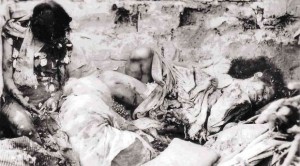
1945: The Rape of Manila By: Joan Orendain, Philippine Daily Inquirer Courtesy of: http://globalnation.inquirer.net/99054/february-1945-the-rape-of-manila DEAD bodies could not be buried as relatives fled the carnage. Photo courtesy of Albert Montilla To this day, much is heard of the Rape of Nanking when the rampaging Japanese Imperial Army killed 300,000 from 1937 to 1938, and raped 20,000 women in that Chinese capital. Pitifully few, though, in the Philippines and even fewer elsewhere, know that in Manila, in February 1945, World War II at its agonizing climax brought forth 100,000 burned, bayoneted, bombed, shelled and shrapneled dead in the span of 28 days. Unborn babies ripped from their mothers’ wombs provided sport: thrown up in the air and caught, impaled on bayonet tips. With rape on the streets and everywhere else, the Bayview Hotel became Manila’s rape center. After the dirty deed was done, nipples were sliced off, and bodies bayoneted open from the neck down. William Manchester in his book “American Caesar,” wrote that “Once Rear Adm. Sanji Iwabuchi had decided to defend Manila, the atrocities began, and the longer the battle raged, the more the Japanese command structure deteriorated, until the uniforms of Nipponese sailors and marines were saturated with Filipino blood. “The devastation of Manila was one of the great tragedies of World War II. Seventy percent of the utilities, 72 percent of the factories, 80 percent of the southern residential district, and 100 percent of the business district were razed…Hospitals were set afire after their patients had been strapped to their beds. The corpses of males were mutilated, females of all ages were raped before they were slain, and babies’ eyeballs gouged out and smeared on walls like jelly.” From ‘Pearl’ to rubble The envy of other Far Eastern cities before the war, lovely Manila, a melting pot of four cultures and the acknowledged Pearl of the Orient, turned completely to rubble and smoldering ash, wrack and ruin in the 28 days it gasped its last. Its face changed forever, national as well as city administrators since then have barely seen to its proper post-war urban planning and reconstruction, with the exception of a few government buildings rebuilt to their original states. (Zoning laws? What’s that?) In dramatic foreshadowing, the Irish Columban priests at Malate Church got a taste of what was to come. An unknown volunteer worker at the Remedios Hospital wrote that on Dec. 22, 1944, “most beloved” Father Patrick Kelly and Father John Lalor, were taken away by enemy soldiers. On Christmas, Dec. 25, 1944, the priests offered dinner for 200 poor folks. “We had to put up a brave front with smiles on our faces and lead in our heart.” The missing priests returned to Malate on Dec. 29 to great rejoicing, but they never talked about what strife they had undergone. A timeline of bloody events as they unfolded helps to remind us that war is hell, through which Manila agonized. Feb. 1, 1945: “Roll out the barrel, Santa Clause is coming,” is the note wrapped in goggles dropped by a plane to starving Allied countries’ civilians interned at the University of Santo Tomas (UST). Feb. 3: American troops arriving from Lingayen liberate the 3,700 interns at UST. Japanese troops commence burning buildings and homes north of Pasig River. Feb. 4: Japanese marines commanded by Rear Adm. Sanji Iwabuchi retreat to Intramuros, blowing up all the bridges across the Pasig. Feb. 9: Ermita and Malate are put to the torch. Nicanor Reyes’ living room is piled high with furniture and drapes; gasoline is poured over them. The founder of Far Eastern University and some members of the family burn there after being bayoneted, but young daughter Lourdes who has hidden in a closet, and her wounded mother and aunt, flee to Leveriza to join her grandmother. Against a wall, the four set up a makeshift shelter with burned GI sheets. In the shelling, Lourdes’ mother who is shielding her, and her aunt, and grandmother, are killed. Sen. Elpidio Quirino’s wife and two daughters, fleeing to his mother-in-law’s home, are felled by Japanese machine guns. THE BATTLE of Manila left the city in total devastation and killed 100,000 Filipino civilians. Photo courtesy of Albert Montilla Jesus Cabarrus Jr. has shrapnel embedded in his skull to constantly remind him of the terror-filled days in Ermita. Ordered by enemy troops to converge at nearby Plaza Ferguson, the men are separated from the women and children, and brought to Manila Hotel (where Jesus Sr. and other men become water boys, and where he saw Walter Loving, the Constabulary Band chief, stabbed to death). Hotel turns into hell Wives and children are ordered to Bayview Hotel where the only water is out of toilet water tanks, and females are wantonly raped. Amid screaming when the building begins to burn, the Cabarruses flee, stepping over bloodied bodies … [Read more...]
http://esdiario.com.mx/el-guro-dino-flores-impartira-seminario-de-lameco-eskrima/ El Guro Dino Flores impartirá seminario de Lameco Eskrima jul 31, 2015 - 3:04 am Deportes Comentarios desactivados La Academia EFA que dirige el profesor Adán Castillejos se prepara para recibir una visita de lujo, pues el Guro Dino Flores estará impartiendo sus conocimientos en un seminario de Lameco Eskrima –Kali Ilusitrisimo-, el cual se desarrollará este próximo 14 y 15 de agosto. Lo anterior fue confirmado por el profesor Adán Castillejos Gallegos quién destacó que este seminario busca la preparación de sus alumnos, por lo que es de suma importancia continuar trabajando en las artes marciales. Indicó que el Guro Dino Flores nació en Hawai. Ha vivido en varios lugares, incluyendo Fiji, Papua Nueva Guinea, Australia, así como Manila y Laguna – Filipinas. Guro Dino se introdujo primero en el concepto de historia “Arnis” y Filipinas Guerrero por su padre el Dr. AS Flores a mediados de 1970. Esto se hizo a través de la tradición oral, Pilipino Komiks y difícil de encontrar publicaciones durante la Ley Marcial. Su primer contacto con el entrenamiento físico fue en la década de 1980 en la provincia de Laguna, Filipinas. Familiares mayores y vecinos de la familia tierras ancestrales de muchas generaciones, lo presentaron en las sesiones de traspatio a aplicaciones básicas de la calle y la estrategia de la hoja balisong durante las estancias en las Filipinas. Muchos de estos primeros instructores habían experimentado situaciones de hoja real con las cicatrices para probarlo. Las primeras lecciones fueron evitación, la conciencia ambiental y el comportamiento adecuado para evitar el conflicto. Dino entrenó durante varios años con el Gran Maestro Conrado A. Manaois en Ninoy Cinco Teros Arnis y Master Henry Bio en Sikaran Arnis en la década de 1980, junto con sus primos Ariel Flores Musgos y Choy Flores. A principios de 1990 fue aceptado como miembro inicial de Punong Guro Edgar Sulites ‘nueva formación Backyard Grupo AKA el Oriehenal Grupo Sulite. Durante el entrenamiento constante en el patio trasero que pasó de ser un boxeador agresivo a uno que ahora más tranquilo y preciso. Su estilo de lucha en los primeros días del Grupo de los Backyard le valió el apodo de “Aso’ng Gulo” de sus compañeros de los compañeros y era considerado combatiente patio trasero favorito Punong Guro Sulites ‘debido a la clara el uso del plan de estudios durante los combates. Además, tuvo la buena fortuna de experimentar el entrenamiento en Kali Ilustrísimo con Dodong Sta. Iglesia, Guro Arnold Narzo, Guro Peachie Baron, Maestro Rey Galang, Maestro Yuli Romo y Master de Tony Diego. También entrenó en Kali Ilustrísimo con uno de sus compañeros de entrenamiento y miembro Lameco Backyard Guro Hans Tan, que fue certificado para enseñar Kali Ilustrsimo con el Maestro, Tony Diego en 1999. Además Guro Dino entrenado en privado durante varios años en California y las Filipinas con el profesor Ireneo L. Olavides en Eskrima De Campo JDC-IO. Guro Dino también cita la importancia de sus compañeros de entrenamiento en Lameco SOG y Kapisanang Mandirigma en su crecimiento. Dino ha impartido numerosos seminarios y clases en los últimos años. Ha aparecido en la televisión, videos instructivos, Cine Independiente y programas de radio promoción de las artes. Ha contribuido al artículo de la revista para publicaciones como “Budo International”, “Maestros”, “Blitz” “FMA informativo” y “FMA Digest. Guro Dino es un miembro fundador de Kapisanang Mandirigma de: Organización de Investigación Mandirigma / Mandirigma.org, Kali Klub sa Filipinotown histórico de Los Ángeles y la Organización Backyard Eskrima ™. El Kali Klub es una colaboración voluntaria con varias agencias sin fines de lucro en Los Ángeles. El proyecto incluye la creación de un programa premiado desviar positivamente la juventud en riesgo de las drogas y las pandillas que usan los filipinos Guerrero Artes como una metáfora para la adaptación y el aprendizaje. Cientos de estudiantes experimentaron el programa a lo largo de diez años. Para algunos estudiantes de la educación salvó literalmente su vida en varias situaciones callejeras armadas. Algunos de los premios y reconocimientos de para el programa provienen de organizaciones como en Buscar para Involucrar Pilipino estadounidenses, la Asamblea Estatal de California y el Ayuntamiento de Los Ángeles. … [Read more...]
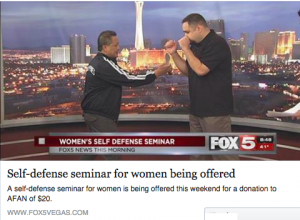
Guro Ariel Flores Mosses of Mandirigma.org/Kapisanang Mandirigma with Sensei Hamm of Ten Tigers on Las Vegas TV promoting Self-Defense Seminar including Filipino Martial Arts. A self-defense seminar for women is being offered this weekend for a donation to AFAN of $20. Read more: http://www.fox5vegas.com/Clip/12133192/self-defense-seminar-for-women-being-offered#ixzz3yo7O1jKi http://www.combatfma.com/ http://www.tentigersmartialarts.com/index.html … [Read more...]
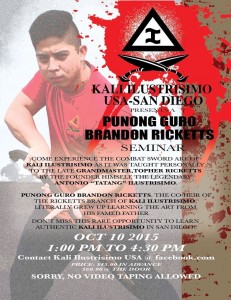
Guro Brandon Ricketts to teach Kali Ilustrisimo in San Diego, California. October 2015. … [Read more...]
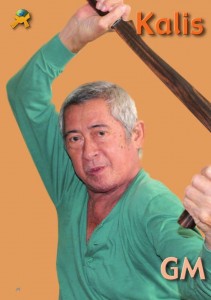
Budo Magazine Publishes the final Interview of Grandmaster Tony Diego of Kalis Ilustrisimo. Interview by Tim Fredianell. Read interview in English here: http://issuu.com/budoweb/docs/martial_arts_magazine_budo_internat_f897c9abdb5660 Read interview in Spanish here: http://issuu.com/budoweb/docs/revista_artes_marciales_cinturon_ne_86c3fa97b13e16?e=1589527%2F30101651 … [Read more...]
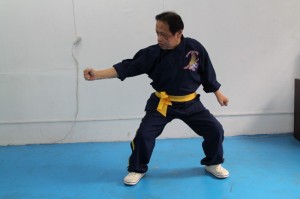
Heart Bypass Fundraiser for Grandmaster Alexander Co Donate Here: https://www.gofundme.com/tp3wnp9c Alex Co is synonymous with martial arts in the Philippines. He is grandmaster of Ngo Cho and Tang Lang, owner of the beloved Squadron Shop, publisher of books and magazines, and supporter of all teachers and styles. Master Co has done so much for so many, never asking for anything in return. His life has been filled with friends and masters and robust health and financial stability. He has been my mentor for over 20 years. Now, he is sick, he is poor, he is weak, and his life is touch and go each month. Master Co suffers from multiple morbidities: Heart Disease, Diabetes, Low Blood Pressure, and Kidney Failure. He can no longer urinate. He has had several surgeries in the past few years. Stents in his heart, stents in his legs, and he is in dialysis 5 hours a day, 4 days per week. He recently almost had his legs amputated. The thing is, Master Co could have a kidney transplant, except his heart it too weak. It is only at 25% function. But he cannot afford the heart bypass to make him strong enough for the kidney transplant. He has spent all his retirement on temporary procedures to keep him alive. But now the doctors told him he has a 50% chance of suffering heart attack each time he is connected to the dialiysis machine. And they have recommended another heart stent. He cannot afford it. So now, the most generous and knowledgeable teacher in Manila, who has been mentor to many and financial supporter of many passed masters, like Tatang Ilustrisimo, Edgar Sulite and more... is at the threshold of life and death. One day feels ok and the next he is flattened and swollen and unable to breath and in need of more temporary surgeries. Those who know and love Master Co, who is only in his mid-60s, do not want this legend to pass from this earth, We ask for your help. He needs your support. A few dollars, a hundred dollars... whatever donation you can manage. If we can raise enough for the heart bypass, the docs say he will be strong enough for the kidney transplant, and perhaps live another 15 years. If we can't do it in time, there may be no more time. Please help, as you can. Please. Donate Here: https://www.gofundme.com/tp3wnp9c A word from Mandirigma.org Grandmaster Alex Co is a longtime practitioner of the Philippine Warrior Arts. He is also a member of Bakbakan International and has published several book on the subject, most notably the books on Lameco Eskrima by Punong Guro Edgar Sulite. Grandmaster Alex is a living Martial Arts treasure of the Philippines. … [Read more...]
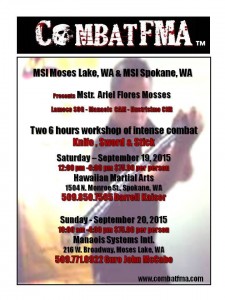
Seminar: Guro Ariel Flores Mosses to teach Lameco Eskrima and Kali Ilustrisimo in Washington State. September 2015. … [Read more...]
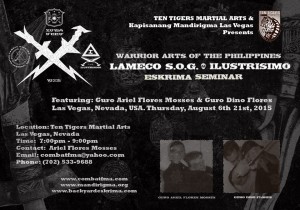
Ten Tigers Martial Arts Las Vegas presents Guro Dino Flores and Guro Ariel Flores Mosses Seminar in Ilustrisimo & Lameco Eskrima. Las Vegas, Nevada, August 6th, 2015 … [Read more...]
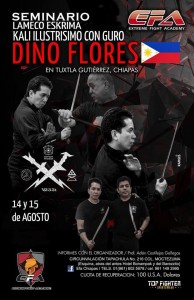
SEMINARIO DE LAMECO ESKRIMA Y KALI ILUSTRISIMO CON GURO DINO FLORES EN TUXTLA GUTIERREZ, CHIAPAS. 14 Y 15 DE AGOSTO … [Read more...]
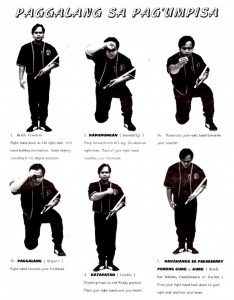
This post is password protected. To view it please enter your password below: Password: … [Read more...]
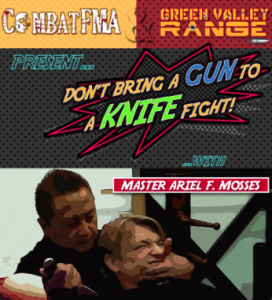
Coming this Summer... Seminar: Don't Bring a Gun to a Knife Fight! with Guro Ariel Flores Mosses. Green Valley Range indoor shooting range in Las Vegas, Nevada. July 18th, 2015. Sometimes you don't have the option to draw and fire on an attacker, so you have to put on your Jason Bourne goggles. Start to see common household items as lethal weapons. Learn to defend yourself with a magazines, pens, Swiffers®, a wooden leg...whatever happens to be within your grasp when danger strikes! Don't Bring a Gun to a Knife Fight! is a 2-hour close-quarters defense class that will have you honing your instincts, boosting your confidence and upping your hand even without drawing your gun. With Master Ariel F. Mosses of CombatFMA as your guide, you will apply the old adage "Necessity is the Mother of jamming a rolled up Newsweek into an No-Goodnik's eye," and discover some new truths of your own by wielding objects both blunt and pointy. Yes, this Saturday, July 18th, you can learn to fight like Jason Bourne. Go check out his pen fight and his magazine fight scenes on Youtube [too graphic for a link here], and then get over and Register Now . Spaces are limited! See you still standing when the smoke clears! Copyright © 2015 Green Valley Range, All rights reserved. Green Valley Range indoor shooting range in Las Vegas, Nevada Our mailing address is: Green Valley Range 175 Cassia Way, Henderson, NV Henderson, NV 89014 More info @ http://combatfma.com/special-events.html More about Guro Ariel at: http://combatfma.com/about-ariel-f.-mosses.html … [Read more...]
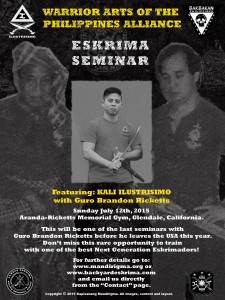
Guro Brandon Ricketts Seminar at Glendale FMA / Aranda - Ricketts Memorial Gym. On July 12 2015 Guro Brandon Ricketts conducted a seminar at Glendale FMA / Aranda - Ricketts Memorial Gym. The Event was hosted by Guro Bud Balani and Guro Dino Flores of the Los Angeles chapters of Lameco SOG, Kali Ilustrisimo and Kapisanang Mandirigma. Attendees came from all over California from places such as San Diego, Santa Barbara, Stockton and San Francisco. Guro Brandon was also supported by some of his students from the USA Headquarters of Kali Ilustrisimo. Guro Brandon Ricketts focused of the fundemental core techniques and how they relate to real time sparring. A concept his father the late Grandmaster Christopher Ricketts drilled into his dedicated students. The seminar concluded with the participant doing some light sparring to test some of the techniques they had just learned in real time. All the participants had a great time with this truly hands on approach to the art. Guro Brandon is leaving for the Philippines at the end of the year. One of his objectives is to take partial administrative charge of his fathers Bakbakan Legacy and bring it into the next generation. The Los Angeles chapters of Lameco SOG, Kali Ilustrisimo and Kapisanang Mandirigma will try to host Guro Brandon Ricketts again for another seminar before he leaves. Check the www.mandirigma.org website for updates. About Guro Brandon Ricketts In 2011 Guro Bruce Ricketts was formally selected as the new Chief Instructor of Master Christopher Ricketts Ilustrisimo Organization and Bakbakan Philippines. The official ceremony was held in Manila, Philippines. During the same ceremony Guro Brandon Ricketts was promoted to the the position as Second in Command to Guro Bruce Ricketts. Also selected was the Administrative Board which includes Guro Ronnie Ricketts, Guro Alex Ricketts and Guro Jason Ricketts. The organization is dedicated to maintaining the legacy of Grandmaster Christopher Ricketts. The Advisory Board was also selected. Guro Bruce Ricketts and Guro Brandon Ricketts trained under their Father, Grandmaster Christopher Ricketts since they could walk. The training room in their Philippine home was located in front of their bedroom. Daily exposure to the arts was the norm. Besides daily training with their Father and other students, many masters spent time training in their home. To name a few, legends such as Master Roland Dantes, Master Rey Galang, Master Yuli Romo, Punong Guro Edgar Sulite, Master Tony Diego and none other than Grandmaster Ilustrisimo himself would train there. The technical and fighting skill of these young Guro’s clearly reflect their esteemed lineage. Guro Bruce and Guro Brandon are also accomplished practitioners of Bakbakan Sagasa Kickboxing, Ngo Cho Kun, Jiu-Jitsu and Boxing. Event Flyer Aranda - Ricketts / Glendale FMA Gym Banner Lameco SOG Members with Guro Brandon. Guro Bud Balani, Guro Dino and Guro Bryan Emerson with his son. Events Hosts with Guro Brandon. Guro Dino, GM Joe Tan, Guro Johnathan Balani, Guro Bud Balani. Guro Brandon giving pointers. Sparring! Sparring! Sparring! Group photo with some of the participants. Sparring! Guro Brandon giving pointers Participants in action. Participants in action. Guro Brandon giving pointers. Guro Johnathan giving pointers. Contact drilling. Contact drilling. … [Read more...]

Eskrima Documentary Series - Teaser Trailer: Ang Dangal Ng Lahi (Pride) Ang Dangal ng Lahi (Pride) is a series of short documentaries about the Warrior Arts of the Philippines commonly known as Eskrima, Arnis and Kali. The focus will be arts and organizations of Bakbakan Philippines, Ilustrisimo and Lameco Eskrima. Director: Tim Fredianelli General Consultant: Dino Flores Distribution: Mandirigma.org Kapisanang Mandirigma Productions Release Date: 2015 For more information go to: http://mandirigma.org/?p=2651 https://vimeo.com/mandirigma/eskrimadors © 2015 Kapisanang Mandirigma Productions, All Rights Reserved. … [Read more...]
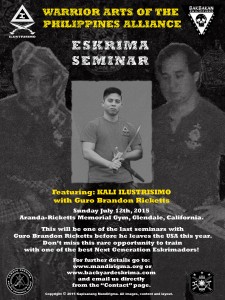
Kali Ilustrisimo Seminar with Guro Brandon Ricketts, July 12, 2015. Glendale FMA, California. A rare opportunity to train with Guro Brandon Ricketts. Guro Brandon grew up with the art and will give you insight into the transition from being a theory based drill practitioner to a real time functional based Eskrimador. Guro Brandon will only be in the USA till the end of 2015 - so don't miss your chance to train with one of the heirs of Grandmaster Christopher Ricketts Ilustrisimo lineage. 10Am to 2PM $50.00 prepaid by friday, July 10th. Spectators $40.00 prepaid. $70.00 at the door. Spectators $60 at the door. Contact: mandirigma.org@gmail.com More info at: http://mandirigma.org/?p=2783 http://backyardeskrima.com/?p=1613 This seminar is open to the general public. No Video Please. No Photography without permission. Brought to you by The Warrior Arts of the Philippines Alliance - Kali Ilustrisimo, Bakbakan Philippines, Lameco SOG, Eskrima, Kapisanang Mandirigma, Combat FMA Las Vegas. ------------------------- In 2011 Guro Bruce Ricketts was formally selected as the new Chief Instructor of Master Christopher Ricketts Ilustrisimo Organization and Bakbakan Philippines. The official ceremony was held in Manila, Philippines. During the same ceremony Guro Brandon Ricketts was promoted to the the position as Second in Command to Guro Bruce Ricketts. Also selected was the Administrative Board which includes Guro Ronnie Ricketts, Guro Alex Ricketts and Guro Jason Ricketts. The organization is dedicated to maintaining the legacy of Grandmaster Christopher Ricketts. The Advisory Board was also selected. Guro Bruce Ricketts and Guro Brandon Ricketts trained under their Father, Grandmaster Christopher Ricketts since they could walk. The training room in their Philippine home was located in front of their bedroom. Daily exposure to the arts was the norm. Besides daily training with their Father and other students, many masters spent time training in their home. To name a few, legends such as Master Roland Dantes, Master Rey Galang, Master Yuli Romo, Punong Guro Edgar Sulite, Master Tony Diego and none other than Grandmaster Ilustrisimo himself would train there. The technical and fighting skill of these young Guro’s clearly reflect their esteemed lineage. Guro Bruce and Guro Brandon are also accomplished practitioners of Bakbakan Sagasa Kickboxing, Ngo Cho Kun, Jiu-Jitsu and Boxing. … [Read more...]
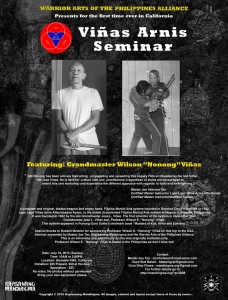
Warrior Arts of the Philippines Alliance Presents for the first time ever in California Viñas Arnis Seminar " GM Nonong has been actively Instructing , propagating and spreading this Legacy FMA art founded by his late father GM Jose Vinas. He is here for a short visit and practitioners irregardless of styles are encouraged to attend this rare workshop and experience the different approach with regards to bolo and knifefighting." Master Joe Valencia Tan Certified Master Instructor Lapu Lapu Vinas Arnis Afficionado Certified Master Instructor Modified Tapado Viñas Arnis is a complete and original, bladed weapon and empty hand, Filipino Martial Arts system founded in Bacolod City, Philippines in 1932. Lapu Lapu Viñas Arnis Affecionados Assoc. is the oldest documented Filipino Martial Arts system in Negros Occidental, Philippines It was founded in 1932 by the late Grandmaster Jose L. Viñas. The first inheritor of the system is none other than Grandmaster Jose L. Viñas son, Professor Wilson E. "Nonong" Viñas. This system appeared in Punong Guro Sulite’s landmark book “Masters of Kali, Arnis and Eskrima”. Seminar presented by Master Joe Tan, Kapisanang Mandirigma and the Warrior Arts of the Philipines Alliance. This is an extremely rare opportunity as this was originally going to be invitation only. Don’t miss out! Date: July 19, 2015 (Sunday) Time: 10AM to 2:00PM. Location: Glendale FMA, California / Aranda - Ricketts Memorial Gym. Donation: $35 Prepaid. $50 at the door. Spectators - $25. Please bring your own training gear. No video. No photos without permission. Contact: Master Joe Tan - comfortwear@roadrunner.com Guro Bud Balani - bbalanigrip@gmail.com Guro Dino Flores - mandirigma.org@gmail.com For further details go to: http://mandirigma.org/?p=2808 The late Grandmaster Jose L. Viñas. The late Grandmaster Jose L. Viñas. Copyright © 2015 Kapisanang Mandirigma. All images, content and layout except those of those by owner. … [Read more...]
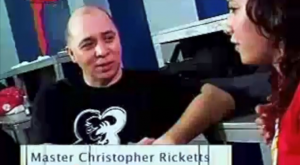
Master Christopher Ricketts and Bakbakan Philippines doing Ilustrisimo on TV Show. Master Ricketts is assisted by Bruce Ricketts, Dodong Sta. Iglesia, Miguel Zubiri, Doran Sordo, Brandon Ricketts, Monsour del Rosario and other members of Bakbakan Philippines. Shot at Olympians Taekwondo Training Center (OTTC) in Fort Bonifacio, Manila, Philippines. 2005. http://www.youtube.com/watch?v=-ZFL1s9N7e4&feature=youtu.be … [Read more...]
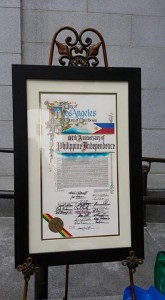
Los Angeles City Hall Celebrate 117th Philippine Independence Day/Araw ng Kalayaan with Kapisanang Mandirigma/Mandirigma.org. June 12th, 2015. Los Angeles, California. Los Angeles City Hall to celebrated the 117th Philippine Independence Day or Araw ng Kalayaan. The event was organizes by the Los Angeles Association of City Employees. Kapisanang Mandirigma/Mandirigma.org demonstrated a sample of the Warrior Arts of the Philippines at the event. In particular the Arts of Lameco Eskrima and Kali Ilustrisimo. This is the second time Kapisanang Mandirigma has appeared at L.A. City Hall. The last time was for the official dedication of L.A. Historic Filipinotown in 2002. The first official Filipinotown in the country. Guro Bud Balani and Guro Dino Flores was assisted by Guro Johnathan Balani, Mark Ramos and Daniel Parker. Their performance was after the flag ceremony in the main building forecourt. The Flag c Ceremony consisted of Filipino-American law enforcement officers parading with various flags of the Philippine Revolution. Los Angeles has the largest population of Filipinos outside of the Philippines. Mabuhay Ang Pilipinas! City of Los Angeles official dedication to the celebration. The demo team with Master Joe Tan of Modified Tapados/Vinias Eskrima Systems. Guro Bud Balani, Dr. A.S. Flores, Guro Dino Flores Demo Team in action headed by Guro Johnathan Balani. Event program. Guro Dino and Guro Johnathan demonstrating single sword techniques as Guro Bud narrates. Filipino-American Law Enforcement Officers parading various flags of the Philippine Revolution. The Eskrima Demo team. Guro Bud Balani and Guro Dino Flores. Filipino-American Law Enforcement Officers parading various flags of the Philippine Revolution. Los Angeles City Hall and L.A. Sister Cities. Photos property of Mandirigma.org. Photographer Dr. A.S. Flores. … [Read more...]
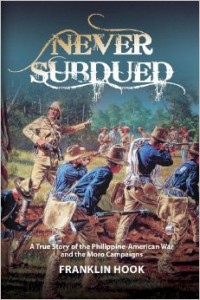
Never Subdued Paperback by W. Franklin Hook (Author) A true story about the Philippine-American War 1898-1902 and how it led to the Moro Campaigns against radical Islam 1902-1913 "[Never Subdued is] a tale of what it was like for a large number of young American men when they "went soljering" more than a century ago, in the steamy tropics of the Philippine Islands during the opening years of the 20th Century. What may surprise you is how uncannily alike "soljering" was then to that of their spiritual military heirs (perhaps including a few of their great and even great-great grandsons or granddaughters) in the cold mountain fastnesses of Afghanistan in the early 21st Century." "[The narrative conveys] the image of a bunch of ordinary young men who got caught up in the historical moment of America's first wars of the 20th Century, enlisted almost on a whim, and took part in an extraordinary adventure. It is as much a human story as a history lesson . . . It relates entirely to the present day." -Robert A. Fulton is the author of Moroland: The History of Uncle Sam and the Moros 1899-1920 Editorial Review From Kirkus Reviews A history of a century-old war with frightening relevance to today's counterinsurgency campaigns.Islamic extremists, guerilla warfare, mountain firefights--Americans are painfully familiar with these things from the recent conflict in Afghanistan. But as Hook notes, the U.S. military faced similar challenges in the Philippines following the Spanish-American War. A retired doctor and reserve Army colonel, Hook spent a decade researching the Philippine-American War and the Moro Campaigns. After Spain ceded the islands to the U.S., American soldiers found themselves battling native Filipinos who previously were glad to see them. Emilio Aguinaldo and his revolutionaries wanted independence from foreign rule, but U.S. policymakers had other ideas. Drawing on soldier diaries, newspaper accounts and other sources, Hook presents a boots-on-the-ground narrative of the bloody insurgency that followed. American soldiers fought the elusive Filipinos while suffering under intense heat, relentless mosquitoes and rampant disease. Careful to note discrepancies and biases in his sources, Hook constructs a timeline that captures the tension as events teeter out of control. He also tries to explain the thinking on both sides, showing how policy blunders, duplicity and prejudice may have exacerbated the hostilities. A peace proclamation in 1902 officially ended the insurgency, but the U.S. still faced the problem of controlling the southern islands, which were predominantly Muslim. Combat with Moro fundamentalists featured brutalities similar to those seen in today's asymmetrical conflicts--hit-and-run attacks, personal jihad and heavy collateral damage on the civilian population. Throughout the book, a cast of colorful characters emerges as politics, war and personal ambition become intertwined. General Leonard Wood's hard-line approach to the Moros seems counterproductive, while John Pershing's more sensitive tactics would not look out of place in a modern Army counterinsurgency manual. Though the book lacks literary flair, it's a balanced look into the fog of war, where allies can become adversaries and the question "What did we accomplish?" is still open for debate.An often-forgotten conflict comes to life in this authentic account of heroism and atrocity, where the difference between rebel and patriot is which side of the line you stand on. … [Read more...]
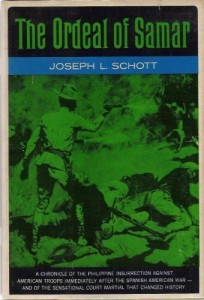
The Ordeal of Samar. Schott, Joseph L. Indianapolis: Bobbs-Merrill, 1964. Hardcover, 302 pages, b&w photographs, index. A chronicle of the Philippine insurrection against American troops immediately after the Spanish American War, and of the sensational court martial that changed history. “The Balangiga massacre was an incident in 1901 in the town of the same name during the Philippine–American War. It initially referred to the killing of about 48 members of the US 9th Infantry by the townspeople allegedly augmented by guerrillas in the town of Balangiga on Samar Island during an attack on September 28 of that year. In the 1960s Filipino nationalists applied it to the retaliatory measures taken on the island. This incident was described as the United States Army's worst defeat since the Battle of the Little Bighorn in 1876. Filipinos regard the attack as one of their bravest acts in the war.” - Wikipedia … [Read more...]
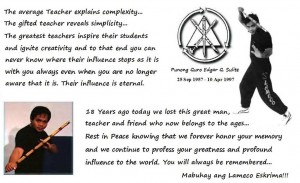
Rest in Peace Punong Guro Edgar G. Sulite on this the 18th year anniversary of your passing, your memory will always be with us. Post courtesy of Guro Dave Gould. … [Read more...]
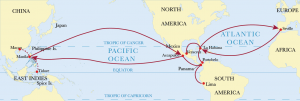
PH, Mexico push to nominate Manila-Acapulco Galleon Trade Route to World Heritage List - From the Department of Foreign Affairs Original Article at: http://www.gov.ph/2015/04/28/ph-mexico-push-to-nominate-manila-acapulco-galleon-trade-route-to-world-heritage-list/ An Experts’ Roundtable Meeting was held at the University of Santo Tomas (UST) on April 23 as part of the preparation of the Philippines for the possible transnational nomination of the Manila-Acapulco Galleon Trade Route to the World Heritage List. The nomination will be made jointly with Mexico. The following are the experts and the topics they discussed during the roundtable meeting: Dr. Celestina Boncan on the Tornaviaje; Dr. Mary Jane A. Bolunia on Shipyards in the Bicol Region; Mr. Sheldon Clyde Jago-on, Bobby Orillaneda, and Ligaya Lacsina on Underwater Archaeology; Dr. Leovino Garcia on Maps and Cartography; Fr. Rene Javellana, S.J. on Fortifications in the Philippines; Felice Sta. Maria on Food; Dr. Fernando Zialcita on Textile; and Regalado Trota Jose on Historical Dimension. The papers presented and discussed during the roundtable meeting will be synthesized into a working document to establish the route’s Outstanding Universal Value. The Manila-Acapulco Galleon Trade bears its remarkable significance for linking four continents and two oceans, contributing to the development of trade in Asia, Europe, North and South America. It paved the way for the widest possible exchange of material goods, cultural traditions and practices, knowledge and belief systems and peoples. For some 250 years, it served as a formidable bridge between East and West. Today, it is considered as an early manifestation of globalization, having influenced the politics, philosophy, commerce, and trade development of almost the entire world. The Galleon Trade firmly put Manila on the world map as the largest trade hub in the Orient with solid historical links to its neighbors. The Route becomes symbolic of UNESCO and the World Heritage Convention’s aims and objectives in establishing peace across nations through shared heritage and a culture of understanding. The roundtable meeting and the nomination of the Manila-Acapulco Galleon Trade Route to the World Heritage List are initiatives of the UNESCO National Commission of the Philippines and the Department of Foreign Affairs, in partnership with the UST Graduate School – Center for Conservation of Cultural Property and Environment in the Tropics. Following the roundtable discussion of the Philippine experts, a series of meetings will be convened for its launch in the international community. dfa.gov.ph … [Read more...]
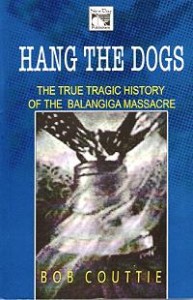
Book Review IN-DEPTH AND INFORMATIVE By Quintin L. Doroquez Original article at : http://gugma.samarnews.net/articles/article8.htm HANG THE DOGS: THE TRUE TRAGIC HISTORY OF THE BALANGIGA MASSACRE BOB COUTTIE New Day Publishers Quezon City, Philippines California Distributor: Philippine Expressions Mail Order Bookshop $24.95 (paper, 462 pages) Hang The Dogs: The True Tragic History of the Balangiga Massacre is quite an intriguing title of a serious book. If the book, or any book for that matter on related title, were set in or were about the British Isles, where the author is originally from, it may outright invite distaste on sight from animal lovers of which Britons mostly are. Hang the dogs -- that's quite a harsh “edict”, coming as it does from a third party (the author) if addressed to a particular party or group alone involved. However, Bob Couttie's edict, if we call the title of his book on the Balangiga Incident as such, is an aphorism directed to the party that did something wrong, the party that should make amend. And in the Balangiga Incident both parties -- the Americans and the Filipinos, to varying degrees -- do need to make amend. In war the two sides, combatants if you will, try to outwit or beat one another. Hence, one side tries to "hang" the other in order to prevail. Whichever side has the upper hand takes the other side as a bunch of dogs to be hung -- “massacred” -- as did (according to historical accounts) the natives of Balangiga on 28 September 1901, if that is the most possible way to achieve what one or the party involved had set out to accomplish. Even scorch and turn a big island into a howling wilderness, as did the Americans to the island of Samar, in the Philippines, in revenge after the Balangiga Incident. The Balangiga Incident took place over a century ago. Therefore, the author’s imperative is now merely a gesture to catch a prospective reader's attention on a commodity in print -- a book. But "hang", which apparently is the author's metaphor for what amounts to kill, destroy, rid, or devour a century ago in war, is all the same throughout the ages. It still is -- to varying degrees. If Bob Couttie were to write a book on the war in Iraq, one could fairly anticipate his title, Strip the Dogs Naked: The True Tragic Story Behind Misled Intelligence. Something of the sort. The facts then emerge. He will portray, with unassailable proof, as he did on Balangiga, that those stripping the dogs naked, whether in a prison or elsewhere in high places of government are themselves dogs, and more. In Hang The Dogs the author actually turns out to be the one hanging the “canines”. He exposes, with unimpeachable evidence, the cravings of the Americans and the Filipinos to devour each other -- the Americans in their lust to create an empire, the Filipinos to resist and prevent being shamed. The “awod” (a local term for shame) factor was overriding among the Filipinos in Balangiga. Bob Couttie does not fail to point this out. So much about the title. Written largely in lean prose, the book is cool. Easy to read. It is the product of a ten-year assiduous research -- possibly the most exhaustive work on the Balangiga Incident thus far, and will remain so for sometime if ever surpassed. Yet still, ironically, at some point the author hedges for want of more facts that he stipulates must be somewhere in some repositories. The book provides a reasonably adequate background of the Philippine Revolution against Spain, as it does of the history of the island of Samar itself where the town of Balangiga, the epicenter of the book, is located. Here and beyond, the author discusses the ferment that led a people to rise in rebellion. Adequately given this background, the author takes the reader quickly to the Philippine-American War. Of the Philippine Revolution against Spain, of interest is the account -- for some reason largely unknown even to many in the Philippines who claim to have good college education -- about the death of Andres Bonifacio, the founder of the secret organization Katipunan that advocated armed struggle against Spain. The author leaves little doubt that Philippine history books -- which Philippine students studied (under ill-prepared so-called professors) in some allegedly reputable schools, particularly in the decades of the ‘60s through the mid ‘80s -- had the truth swept under the rug. That is of course the period largely of the Marcosian era. And whoever may dispute Bob Couttie’s facts only exposes her/his inadequacy or ignorance. The author candidly discusses the sad event leading to the execution of the Katipunan’s “Supremo”, the title that the founder of the secret organization had chosen for himself. The next scenario becomes predictable, the emergence of Emilio Aguinaldo, Bonifacio’s rival who displayed considerable talent early in his military career, as an undisputed military and civilian leader of a people who for over … [Read more...]
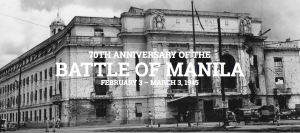
70TH ANNIVERSARY OF THE BATTLE OF MANILA by http://www.gov.ph The battle for the liberation of Manila—waged from February 3 to March 3, 1945, between Philippine and American forces, and the Imperial Japanese forces—is widely considered to be one of the greatest tragedies of the Second World War. One hundred thousand men, women, and children perished. Architectural heritage was reduced to rubble—the City of Manila was the second most devastated Allied capital of World War II. “The destruction of Manila was one of the greatest tragedies of World War II. Of Allied capitals in those war years, only Warsaw suffered more. Seventy percent of the utilities, 75 percent of the factories, 80 percent of the southern residential district, and 100 percent of the business district was razed.” — William Manchester, author and historian, in American Caesar “We remember them, nor shall we ever forget.” — National Artist for Literature Nick Joaquin, on the lives taken during the Battle of Manila, in the inscription of the Memorare Manila 1945 Monument in Intramuros Continue reading at: http://www.gov.ph/featured/battle-of-manila/ https://www.youtube.com/watch?list=PLIcUoXKTZ0KWXjXivC_RK5wwc084lZvsz&v=UdfxZrqvq1c … [Read more...]
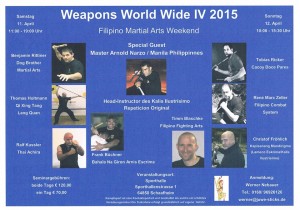
https://www.facebook.com/groups/198916796845259/?fref=ts Weapons World Wide IV 2015 - Filipino Martial Arts Weekend Mit Special Guest Master Arnold Narzo (Manila Phillippines) / Kalis Ilustrisimo Repecticion Original der zum WWW IV eigens aus Manila anreist. Er wird das Seminar am Samstag mit einem 2-stündigen Rahmenprogramm eröffnen und danach die Einheiten von Christof Fröhlich leiten. Die Referenten an beiden Tagen: Timm Blaschke - Filipino Fighting Arts http://www.filipino-fighting-arts.com/ Frank Büchner / Bahala Na Giron Arnis Escrima http://www.bahalana.de/ Christof Fröhlich Kapisanang Mandirigma Tobias Ricker - Cacoy Doce Pares Eskrima http://www.kungfu-frankfurt.de/trainer.html Benjamin Rittiner - Dog Brothers Martial Arts www.dogbrothers.ch Thomas Holdtmann http://www.qixingtanglang.de/ Ralf Kussler www. Ralf - Kussler. Com René Marc Zeller - Filipino Combat Systems http://www.fcs-germany.de/ Auch 2015 steht das Wochenende wieder im Zeichen von Stock und Klinge. Präsentiert werden acht verschiedene Stile/Systeme der philippinischen Kampfkünste. Das Seminar steht jedem offen und es ist sicher für jeden etwas dabei, ob Anfänger oder ehemaliger Anfänger. Neun der besten Referenten der philippinischen Kampfkünste werden sicher für viel Spaß und nachhaltige Eindrücke sorgen. Achtung: Übernachten in der Sporthalle möglich. Samstag Abendessen ab 20.00 Uhr Buffet mit allen Schikanen im TV Schaafheim -Sportheim Essen bis die Lähmung eintritt Preis 15.- € unbedingt vorher bestellen Frühstücksbuffet am Sonntagmorgen in der Halle 5.-€ Essen und Trinken bis zum Abwinken Der Erlös wird einem caritativen Zweck zugeführt Wenn gewünscht bitte bei der Anmeldung mitbestellen. Hotels: in und um Schaafheim Hotel Garni Gästehaus Irene Daimler Str. 10 64850 Schaafheim Tel.: 06073-87850 Fax: 06073-88644 E-mail-Anschrift: bernhardts@t-online.de www.bernhardts-schlemmerservice.de] Hotel Deutscher Hof Bismarckplatz 4 64832 Babenhausen Tel. (06073) 6046-0 Appartments und Hotel Ziegelruh Ziegelruh 1 64832 Babenhausen Tel. (06073) 7267-0 Gaststätte Zur Eisenbahn Grabenstraße 69 63762 Großostheim 06026/8485 Landgasthof Hock An der Kuhpforte 1 63762 Großostheim/Pflaumheim 06026/97160 Gaststätte Zur Post Großostheimer Str. 8 63762 Großostheim/Pflaumheim 06026/1422 Pension Ringheimer Hof Hasselstraße 9 63762 Großostheim-Ringheim internet: www.ringheimer-hof.npage.de e-mail: ringheimer.hof@googlemail.com FON/FAX: 0 60 26 - 99 35 39 Mobil: 01 51 / 25 27 75 80 Hotel Cafe Kern Familie Kern Breite Str. 77 63762 Großostheim eMail: info@hotel-cafe-kern.de Tel:06026/978740 Fax:06026/2656 Hotel Rosengarten Dellweg 8 63762 Großostheim internet: www.rosengarten-hill.de] e-mail: hotel@rosengarten-hill.de Tel:06026/1887 Fax:06026/2989 Landhaushotel Familie Zimmermann Ostring 8a 63762 Großostheim/Ringheim Tel:06026/6081 Fax:06026/2212 Benötigt werden 2 Rattanstöcke 70 cm, 1 Traingsmesser und persönliche Schutzausrüstung wie gewünscht, wie Handschuhe, Schutzbrille, etc. 1 Langstock von 160 cm aufwärts wer hat mitbringen für die Einheit bei Gong Fu Thomas Holdtmann JuWe-Sticks und Panabas y Puntadas werden an beiden Tagen wieder mit einem Verkaufsstand und SICHER guten Lehrgangspreisen dabei sein :o)) http://www.juwe-sticks.de/ http://www.panabas.com/] Samstag, 11. April, 11:00 – 19:00 Uhr Sonntag, 10. April, 10:00 – 16:00 Uhr Seminargebühren: beide Tage 120,- € ein Tag 70,- € Anmeldung: Werner Nebauer 0160 / 96926125 werner@juwe-sticks.de ====================================================================================== IF YOU NEED FURTHER ASSISTANCE DON'T HESITATE TO CONTACT US!!! ENGLISH: Weapons World Wide IV 2015 - Filipino Martial Arts Weekend Special Guest: Master Arnold Narzo (Manila Phillippines) / Kalis Ilustrisimo Repecticion Original who will be travelling from the phillipines for this seminar. He will open the seminar Saturday Morning with a 2 hour presentation of his art and will then teach the lessons of Christof Froehlich The instructors on both days are the following: Timm Blaschke - Filipino Fighting Arts http://www.filipino-fighting-arts.com/ Frank Buechner / Bahala Na Giron Arnis Escrima http://www.bahalana.de/ Christof Froehlich Kapisanang Mandirigma Tobias Ricker - Cacoy Doce Pares Eskrima http://www.kungfu-frankfurt.de/trainer.html Benjamin Rittiner - Dog Brothers Martial Arts www.dogbrothers.ch Thomas Holtmann http://www.qixingtanglang.de/ Ralf Kussler www. Ralf - Kussler. Com René Marc Zeller - Filipino Combat Systems http://www.fcs-germany.de/ In 2015 the weekend will be determined by the blade and the stick again. 8 different styles of filipino martial arts will be presented that weekend! The seminar is open for everybody, no matter if you’re a … [Read more...]
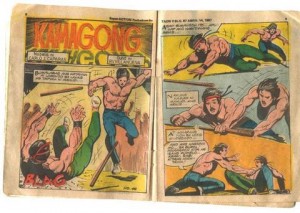
Kamagong (1986 Filipino Arnis film) - with English subtitles https://www.youtube.com/watch?v=csJaY6la970&feature=youtu.be Studio Viva Films Description It started as a weekly comic series in Super Action Pocketkomiks written by the legendary Filipino writer Carlo J. Caparas. It was later adapted into in a movie that stars Lito Lapid as Manuel andJC Bonnin as Ariel in 1986. Plot Outline The plot is about a sacred pair of arnis sticks " Kamagong". Lorenzo (the villian) steals the Kamagong and kills Ariel's brother in a duel. Ariel vows revenge and to get Kamagong back from Lorenzo. Manuel and his Grandmaster trained the Ariel for his his match against Lorenzo. The movie ended with a climatic double stick battle witness by the whole town. There was even a cameo appearance by Angel Cabales. Starring Lito Lapid, J.C. Bonnin, Ruel Vernal, Mia Prats, Bong Dimayacyac, Dencio Padilla, Eddie Garcia, Jaime Fabregas, Beth Bautista Directed By Carlo J. Caparas Written By Carlo J. Caparas Screenplay By Carlo J. Caparas and Rene O. Villanueva Produced By Vic Del Rosario, Jr., Tony Gloria, and Ramon Salvador KAMAGONG KOMIK Illustrated by Rudy V. Villanueva Super Action Pocketkomiks, 1986-1987 … [Read more...]
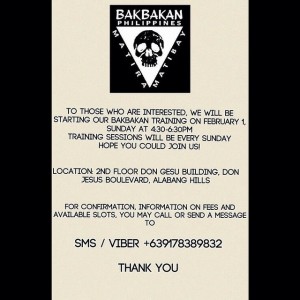
Bakbakan Philippines Classes in Alabang, 2015. … [Read more...]
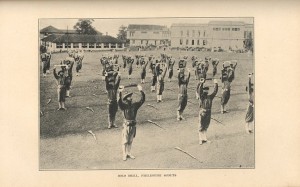
(Photo courtesy of the Philippine Scouts Heritage Society) … [Read more...]
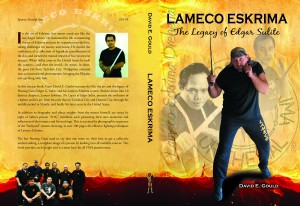
New Lameco Eskrima Book by Guro David Gould released 2014. Published by Mark Wiley's - Tambuli Media. In the art of Eskrima, few names stand out like the late Edgar Salute’s. He dedicated his life to mastering the art of Eskrima and put his reputation on the line, taking challenges for money and honor. He earned the confidence of a collection of legendary grandmasters of the day, and earned the mutual respect of his era’s newest masters. When Sulite came to the United States he took the country—and then the world—by storm. In this unique book, Guro David E. Gould recounts the life, the art and the legacy of Punong Guro Edgar G. Sulite and his Lameco Eskrima system. Broken down into 10 distinct chapters, Lameco Eskrima: The Legacy of Edgar Sulite, presents the evolution of a fighter and his art, from his early days in Tacloban City and Ozamis City, through his middle period in Manila, and finally his later years in the United States. http://www.amazon.com/Lameco-Eskrima-Legacy-Edgar-Suilite/dp/0692306757/ref=sr_1_2?ie=UTF8&qid=1415230995&sr=8-2&keywords=lameco+eskrima http://tambulimedia.com/ … [Read more...]
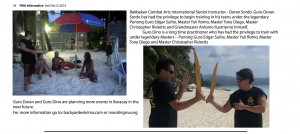
Lameco/Ilustrisimo/Bakbakan Workshop with Guro Doran Sordo and Guro Dino Flores in FMA Informative Newspaper Vol3 No12 – 2014 … [Read more...]
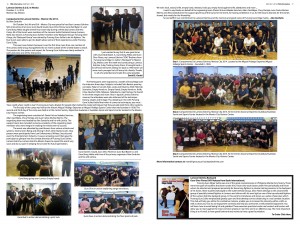
Lameco Eskrima Mexico Camp 2014 in FMA Informative Newspaper - Vol3 No11 - 2014 … [Read more...]
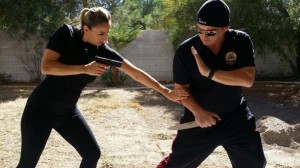
Quarter Gun vs Knife Tactics - 8 week course with live fire in Las Vegas, Nevada. Close Quarter Gun vs Knife Tactics - 8 week course with live fire in Las Vegas, Nevada. With Guro Ariel Mosses of Combat FMA http://t.co/S7hhM1WbGm http://combatfma.com/special-events.html http://combatfma.com/about-ariel-f.-mosses.html … [Read more...]
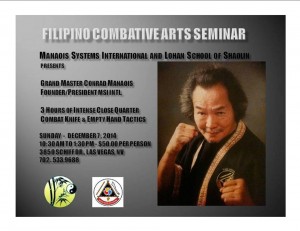
Grand Master Conrad A. Manaois Workshop Grand Master Conrad A. Manaois will be conducting a workshop this Sunday Dec. 7 at Las Vegas Lohan School of Shaolin showcasing his combat proven, close quarter fighting techniques! … [Read more...]
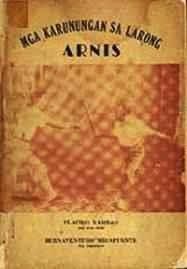
The first written account of "KALI" as the pre-Hispanic name of the Filipino Martial Arts Source: http://fmahistoryredux.blogspot.com/2014/11/the-first-written-account-of-kali-as.html?spref=fb http://fmahistoryredux.blogspot.com/2014/11/philippine-hero-rev-fr-gregorio-aglipay.html “Mga Karunungan sa Larong Arnis” by Placido Yambao and Buenaventura Mirafuente, University of the Philippines Press, 1957... the first book on the Filipino Martial Arts that we know now... its section on the history of the Filipino Martial Arts stated that when the Spaniards arrived in the Philippines, Filipino Martial Arts was not yet called "ARNIS" but "KALI" (“Ang KALI na dinatnan ng mga Kastila ay hindi pa ARNIS ang tawag noong 1610")... The book also mentioned that a KALI demonstration was once performed in honor of the newly-arrived Conquistador Miguel Lopez de Legazpi on the order of a tribal leader in the Island of Leyte... Philippine Hero Rev. Fr. Gregorio Aglipay, the source of Yambao & Mirafuente's "KALI"... REV. FR. GREGORIO AGLIPAY, 1860-1940 (center), the first Supreme Bishop of the Philippine Independent Church (Wikipedia photo)...Rev. Fr. Aglipay was the source of the information that the original name of the Filipino Martial Arts is KALI in the book “Mga Karunungan sa Larong Arnis” authored by Placido Yambao and Buenaventura Mirafuente (University of the Philippines Press, 1957):'Ang KALI na Dinatnan ng mga Kastila ay Hindi pa Arnis ang Tawag nuong 1610.... Noong unang panahon ang larong ito'y kilala sa tawag na "KALI" ng ating mga ninuno, nguni't sa hindi maiwasang pagbabago ng panahon at pangyayari (underscoring mine) ay pinamagatan nila ng "Panandata" sa Tagalog, "Pagkalikali" sa kapatagan ng Kagayan ng mga Ibanag, "Kalirongan" sa Pangasinan, "Kaliradman" sa Bisaya at "Pagaradman" sa Ilongo nuong 1860, at "Didya" sa Ilokos at muling naging "Kabaroan," ayon kay Rev. Fr. Gregorio Aglipay na bantog din sa arnis nuong 1872.'TRANSLATION: 'The indigenous martial art that the Spanish encountered in 1610 was not yet called Arnis at that time. During those times, this martial art was known as "KALI" to our ancestors. Due to theunavoidable changing of the times and circumstances (underscoring mine), this martial art became known as "Panandata" to the Tagalogs, "Pagkalikali" to the Ibanags of the plains of Cagayan, "Kalirongan" to the people of Pangasinan, "Kaliradman" to the Visayans, "Pagaradman" to the Ilonggos in 1860, and "Didya" to the Ilocanos (but later on changed to "Kabaroan"). This is according to Rev. Fr. Gregorio Aglipay, who himself was a famous Arnis practitioner in 1872.' … [Read more...]
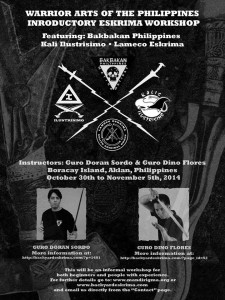
Bakbakan Combat Arts International Senior Instructor -Doran Sordo. Guro Doran Sordo has had the privilege to begin training in his teens under the legendary Punong Guro Edgar Sulite, Master Yuli Romo, Master Tony Diego, Master Christopher Ricketts and Grandmaster Antonio Ilustrisimo himself. Guro Dino is a long time practitioner who has had the privilege to train with under legendary Masters - Punong Guro Edgar Sulite, Master Yuli Romo, Master Tony Diego and Master Christopher Ricketts. … [Read more...]
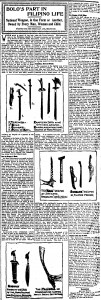
Filipino Martial Arts Reported in a New York Newspaper, 1900 Article From: http://martialartsnewyork.org/2014/10/14/filipino-martial-arts-reported-in-a-new-york-newspaper-1900/ On October 28, 1900, a lengthy article appeared in the Rochester Democrat and Chronicle, describing the many weapons used by the native inhabitants of the Philippines, as well as details pertaining to the method of their use, and rituals in the duel. The article, complete with illustrations, is probably one of the first in America to detail the martial culture of the Philippines, and is almost certainly the first such article to appear in New York State. Although Filipino martial arts such as Kali and Arnis had likely not yet made their appearances in New York, this article offers a fascinating glimpse at how such fighting arts were viewed by visiting Americans at the turn of the century. After an initial examination of the social importance of the Bolo and its method of manufacture, the article proceeds to describe other indigenous weapons and their manner of use. The first is the Sundang, or northern (Luzon) version of the Bolo: “The weapon is curiously shaped and cunningly balanced so as to throw the weight toward the striking end. Even a light blow is terribly effective. The average Filipino is as dextrous in handling the sundang as a fencing master is with the rapier.” Next, the Campilan is described: “It is carried over the shoulder and is never unsheathed for the first stroke. When necessity for its use arises it is brought down on the head with the scabbard on it. The blade cuts through the thread, thus unsheathing itself…There is a regular drill the Moros go through with this weapon, cutting and chopping with extraordinary swiftness while continually leaping hither and thither to avoid the return of the enemy. An individual encounter between two natives armed with the campilan presents a curious and startling spectacle. One sees the sudden stroke, hears the clap and rattle of the wooden scabbard as it lands and watches it fall to the ground in halves…It seems hideously incongruous that the recipient of the stroke should go down with his skull split at the same moment. But the sheathed steel does its work swiftly and such duels are over with the first swing that reaches the mark.” Next, the article describes the method of using the Kris, the staff officer’s favorite weapon: “The approved kris stroke is for the body with a peculiar weaving motion of the wrist, supposed to send the blade home and spread the wound…it is brandished above the head of the charging leader, a beacon of victory.” Also described is the smaller punal de kris, a “diminutive but deadly weapon,” as well as the quinabasi, or knife of the private soldier: “He carries it very much as the American private does his bayonet…Generally speaking it is a utensil rather than a weapon, though by no means to be despised at close quarters.” The author describes other weapons as well such as the terciada, borong, andtalibong. If you’d like to read more, the entire article can be loaded and read by clicking on the image below. Also, if you enjoyed this article, see: Filipino versus Spanish Knife Fighters and a Duel in New York City, 1931 … [Read more...]
Tribute and tribulation by Romeo Macapagal for Manila Times. A Tribute to Grandmaster Tony Diego. Original article at this link: http://www.manilatimes.net/tribute-tribulation/122855/ When a human being rises to the greatest heights of achievement possible in spite of in surmountable obstacles, this is greatness. When this level of accomplishment is matched with kindness and compassion, with surpassing generosity even at the sacrifice of personal material needs, this greatness is defined by spirituality and becomes the “Grandeur of the Human Spirit.” This was Antonio Ramoneda Diego. Father, husband, friend, student, mentor, benefactor. A measure of Tony’s humanity and greatness is the fact that he has raised a brood of eight children, two children-in-law, and two grandchildren, and yet none of these children are his and his wife’s biological issue. Yet, he has struggled, worked hard and honestly to raise them, still looking after them till the time of his death, being especially fond of the grandchildren. As a husband, Tony was especially devoted to his wife Gelynn and loved her so much he could not face life without her. When she was stricken with cancer, he too deteriorated in health and overtook her in death. Gelynn is now very frail and may follow Tony soon. It seems she too cannot live without Tony. When his house burned down, the proceeds of his retirement went up in smoke. It is a measure of his loving, caring character that his students gathered resources so that Tony could rebuild his house to provide a home for his family. And when his wife needed medical care, his students returned in full measure the loving attention and generous instruction he had given them. He was as attentive, caring and generous to his students as he was with his own children. Under Antonio “Tatang” Ilustrisimo, Tony was a diligent student, loyal and generous as much as his resources would allow. He modeled Tatang in practically every aspect of living and his goal was to become exactly like Tatang. When Tony became a master in his own right, he taught ceaselessly, sharing unstintingly of his knowledge. He studied and planned endlessly to be able to transmit his knowledge and skill to the increasing number of adherents to the Ilustrisimo system under him. Tony contributed very much to the popularity and fame of Filipino Martial Arts (FMA). He had given a foreign seminar only once, 30 years ago, and in spite of moving no further than the confines of Tondo district, the Luneta, and rarely beyond the City of Manila, he was able to contribute to the fame of the FMA, that icon of the Filipino, so that the FMA is the object of study of so many followers around the world. Tony was a good friend, warm, generous, loyal and sincere. He had a gift of natural leadership and charisma. While prone to fits of temper, this was mostly directed at those who would offend his friends. Tony’s material resources were never enough. Yet he maintained his dignity and honesty at his work as a stevedoring supervisor and later manager. Even when other FMA teachers were making a good living from student’s payments, Tony remained undemanding, accepting whatever amount was given him, never charging a fixed fee. When paid, he took care to share with those who helped him teach. Even when his house burned down, part of funds he received for reconstruction were shared as food for his neighboring fire victims. Tony’s undemanding and gentle approach made him victim by many unscrupulous students who exploited his knowledge and generous nature. He would be hurt by their actions but then forgave easily. The trials and tribulations of Tony’s life eventually wore him down, both physically and emotionally, but his spirit as a swordsman and teacher prevailed, always thinking of the future of his students in terms of their continuing learning. A man’s character is measured by the sincere regard given him by others. With Tony, it is the love, affection and gratitude given by students all over the world to provide for those he has left behind because they know he loved them so much. Tony is gone, and like all great men there is no replacing him. Once in several lifetimes, there are such men as him, but not very often. Faced with adversity, they triumph over obstacles to rise to the heights of greatness in their chosen field. Like the “Grand Old Man of the Sword,” Antonio “Tatang” Ilustrisimo, his master, teacher and model, Antonio “Tony” Diego has achieved greatness. Original article at this link: http://www.manilatimes.net/tribute-tribulation/122855/ … [Read more...]

I met Mang Tony Diego Kalis Ilustrisimo around 1986. He was introduced to me by my master, GM Topher Ricketts when we would accompany him to practice at the Luneta park on Sundays or the gym in Binondo. As the years passed, Master Topher would always ask Master Tony to teach me some techniques and polish details in my form whether it be stance, swing, footwork, etc. Master Tony was always so generous in his teaching and would share so much. I know him to be a quiet, humble man who would always tell me not to call him "Master". Whenever he saw me, he would always fondly greet me by exclaiming "Sord!" and he always had a smile on his face whenever i came to Luneta. We would sit sometimes between practice and just chat. He would tell me about the good old days with Master Topher, showing me techniques while we were chatting. How he remembers us when we were still young and would joke that we were thinner then. He was a learned man, who would often ask me how my spiritual practice was coming along. I remember one of the last conversations I had with Master Topher before he passed away. He told me "Never forget your Ilustrisimo. See Master Tony as often as you can and learn as much as you can. You practice what you learn until you are old." I remember now the last conversation i had with Master Tony at his home in Tondo. He said to always be mindful of the details. I remember the last time I saw him. It was a day before he passed away. We said a prayer together and I went downstairs so he could rest. I am honoured to be his student and proud to continue his legacy however way I can. I feel privileged to have been able to spend some time with him and learn from this great teacher. I can almost hear swords clashing as he is reunited once again with Grand Master Tatang Ilustrisimo, GM Topher Ricketts and PG Edgar Sulite. We miss you Master Tony. Paalam Po, GM Tony Diego. Pugay … [Read more...]
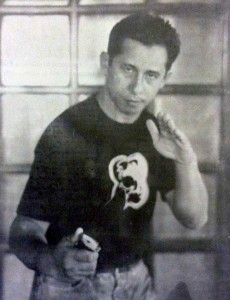
Rest In Peace Master Tony Diego, Head of Kalis Ilustrisimo. Rest In Peace Master Tony Diego. Thank you for the friendship, knowledge and wisdom you shared. I hope you are now happily practicing again with your dear teacher - Grandmaster Antonio Ilustrisimo. Along with your old training buddies Master Christopher Ricketts and Punong Guro Edgar Sulite who also departed way too soon. Love & Respect,Dino Flores … [Read more...]
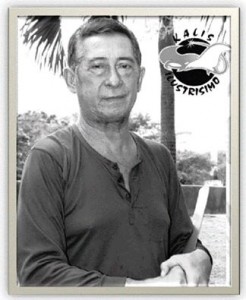
Guro Dave Gould of Lameco Eskrima pays tribute to Grandmaster Tony Diego of Kalis Ilustrismo. I just wanted to pass on some sad news, that being the passing of Grand Master Tony Diego of Kalis Ilustrisimo fame. He passed due to a long illness yesterday on August 25, 2014 (Philippine Time). GM Tony Diego and Master Yuli Romo were the first students of GM Antonio "Tatang" Ilustrisimo who formally began their training with the old battle tested Grand Master in 1977. years later along came PG Edgar G. Sulite, Master Christopher N. Ricketts and Master Rey Galang who were recognized as the 5 Pillars of Kalis Ilustrisimo and were credited with spending the most time training directly under the astute tutelage of GM Antonio "Tatang" Ilustrisimo as well as them being credited with better organizing the Kalis Ilustrisimo system and creating its curriculum based on the movements and reactions of their teacher, "Tatang" Ilustrisimo regarding that discipline. For us in the Lameco Eskrima System Master Tony Diego was a great influence and he was the one who really brought PG Edgar G. Sulite to Kalis Ilustrisimo and to GM Antonio "Tatang" Ilustrisimo, basically resulting from a sparring match between PG Edgar G. Sulite and Master Tony Diego, this was a defining moment in the evolution of the Lameco Eskrima System as we know it today, simply because up until this sparring session Lameco Eskrima was comprised of only 4 major influences, those being; De Campo 1-2-3 Orehenal, Kali Pekiti-Tirsia, Modernos Largos and the Sulite Rapelon Style along with the 6 minor influences of the system. Kalis Ilustrisimo would prove to be the missing piece of the system and this was discovered during that very crucial sparring session between PG Edgar G.Sulite and Master Tony Diego so many years ago. The result of that sparring match saw PG Edgar G. Sulite becoming a student of Kalis Ilustrisimo under GM Antonio "Tatang" Ilustrisimo and over the years adding countless techniques, concepts and principles from Kalis Ilustrisimo to the Lameco Eskrima curriculum to strike a fine balance to the system, especially regarding the blade and dagger portion of the curriculum. Master Tony Diego became fast friends with PG Edgar G. Sulite and remained a very close friend for the rest of Edgar`s life and was partially responsible for the International Recognition of Kalis Ilustrisimo, Bakbakan International and Lameco Eskrima International along with Master Yuli Romo, Master Christopher Ricketts, PG Edgar G. Sulite and Master Rey Galang. After GM Antonio "Tatang" Ilustrisimo Passed away in 1997 Master Tony Diego being the heir apparent of the system was elected by the other senior members of kalis Ilustrisimo to take control of the system. It is a shame that he has been taken from us but he was taken contributing much back to the Filipino Warrior Arts Community from which much was given him over his life time. Rest in Peace Master Tony Diego and long live your legacy! … [Read more...]
Respecting the Grand Masters of the Warrior Arts in the Philippines by Jay Ignacio Those who have seen The Bladed Hand would have understood that a lot of the Grand Masters in the Philippines are not well-off. They live in very tough conditions, some are employed for a paltry sum, and there are others who have no source of income other than when they have students to teach.Please be understanding when you approach them and do not ask for discounted rates, or take advantage of them by giving them empty promises of compensation or trips abroad.FMA may give some folks abroad a decent income, or even "street cred", but here in the Philippines, these Masters do not own gyms or schools or training facilities. They teach in public parks, or give private lessons at the students' homes.Pay them on time whatever rate you agreed on per session, and have the decency to acknowledge them for what they taught you. Pay, or at the very least, offer to pay them for their cab, or bus, or jeepney ride to meet up with you. Feed them as well, especially if ask to meet at a cafe or restaurant.Be mindful of the fact that photo ops with the Masters sometimes have consequences not favorable to them. Note that when you bug them to give you a certificate (when they normally don't because they have no registered business for their FMA system) for just a few days or hours of training, you are taking something away from them. There's just too much of this going around. A lot of them complain, but there is no avenue for them to adress any of their concerns. Sometimes they give in because they have no choice. It's a matter of understanding, and of respecting their intellectual property, among other things. http://youtu.be/2LK2SNOWqdI … [Read more...]
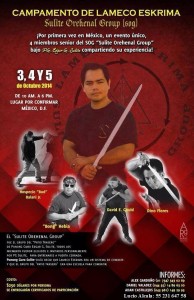
Lameco Eskrima S.O.G. in Mexico. October 3, 4, 5 - 2014. … [Read more...]
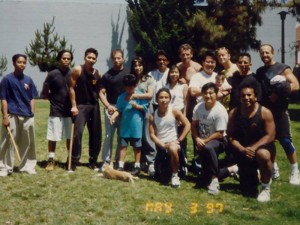
Photo Archive: Lameco Practitioners & Friends at the Dog Brothers Gathering in 1997 Photo courtesy of Arnold Noche. This photo was taken in 1997. It was at the Dog Brothers Gathering in Hermosa Beach, California. Arnold was in town from NYC. Some of the people in the photo: Arnold Noche, Dino Flores, Ron Balicki, Diana Inosanto, Sebastian, Al, Perla, JP, Crafty Dog, Hans Tan, Nick Papadakis, Sung Han, Felix and Dogzilla. … [Read more...]
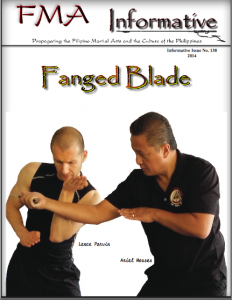
FMA Informative - Issue 138 - Fanged Blade What is the Fanged Blade Program? -Technique Examples --Fanged Blade --Manaois System --Lameco Footwork Within Filipino Martial Arts A Tactical Professionals’ View Fanged Blade in Action - A Students’ Perspective The Cultural Arts Training Foundation The FMA Informative in talking with Lance Parvin found out that the Fanged Blade was created by Ariel Mosses and Lance Parvin to address worst-case scenarios. The program incorporates several arts and systems, mainly comprised of Filipino martial arts including: Lameco S.O.G, Kali Ilustrisimo, and Manaois Eskrima, Ninoy Cinco Teros Arnis. Based on violent, destructive, and killing strikes, Filipino ground fighting (Buno), and “uninterrupted biting and eye gouging” (Kagatin at Mangamot ng Mata) techniques are emphasized. Fanged Blade comes under the main organization, “The Cultural Arts Training Foundation” which uses movement arts to empower those dealing with traumatic injury, PTSD, and bullying. The programs are developed by qualified professionals with dynamic backgrounds in movement including: kinesiology, gymnastics, martial arts, dance, and yoga. Lance Parvin, Founder and Executive Director, created the organization after his own traumatic injury from a near fatal car accident left him with spine damage. Visit www.fmainformative.info and download a copy. Link - www.fmainformative.info/Informative_Issues/2014/FMA_Informative-Issue138.pdf … [Read more...]
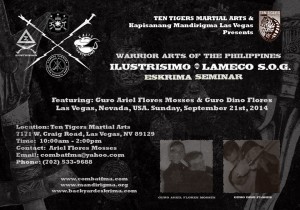
Ten Tigers Martial Arts Las Vegas presents Guro Dino Flores and Guro Ariel Flores Mosses Seminar in Ilustrisimo & Lameco Eskrima. Las Vegas, Nevada, Saturday, September 21st, 2014 … [Read more...]
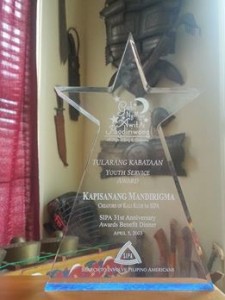
Guro Dino from Kapisanang Mandirigma reflects on teaching Eskrima at the Non-Profit organizations in Historic Filipinotown, Los Angeles. When our teacher Punong Guro Edgar Sulite passed away, the group wanted to honor his work but in the least commercial way possible. We weren't sure how we could do it...and looking back I am not sure why we wanted to do it that way. One day after one of our countless demos around the city, Aki from PWC approached me to do a history workshop at Glendale City College. Afterwards she asked if I would like to use the art to help at risk to kids to gangs violence and drug use. My first reaction was "are you sure?" I was thinking we are kind of a rough bunch and we are wielding sticks, knives and swords and were more like a gang ourselves. I didn't think it was exactly appropriate at the time. I was reminded that the Rampart district (where the movie "Training Day" was set) had the highest murder rate in the city at the time and was kind of rough itself with numerous hyper violent gangs such as MS13 and 18th St. claiming the area as their turf. Thus I half heartedly accepted. Anyway, to cut a long story short - our recruiter was right. We had a surprisingly high success rate with the youth. Just a few minor glitches like gunshot wounds, knife fights, comas and molotov cocktails on roofs...but thats another story.From what I can gather, most of the rougher kids changed their ways....after maybe a little backyard method persuasion techniques. Two things were very effective. 1.Military style drilling, rules and lots of push ups for the whole class if someone was out of line - Guro Bud was an expert at this method. 2. Lots and lots of sparring. Be it Eskrima, Grappling, Kickboxing etc. If they were very bad they would have to spar everyone in class ending with me. It was truly a transformative and effective method...but probably illegal in several states...lol. Some parents told us their kids grades had gone up. Another parent told us that a school teacher said to her that her son was "The most moral student in the school" (since joining the program)...still makes me laugh. We had an amazing experience doing volunteer work with those great Non-Profit Community organization like SIPA, PWC and FilAm ARTS. The at risk youth positive diversion program from gangs and drugs we taught from 1997 to 2004 was a big learning experience for us all. I am proud that when government funding was low or disappeared, we didn't let it stop us. Instead myself, Guro Arnold A. Noche and Guro Bud Balani Jr. offered adult classes at the centers at an affordable rate and used the proceeds to assist in funding the youth programs. One of the adult students even got Asics to sponsor us for a semester and we got some cases of their wrestling shoes. It was a grand adventure that took us far and wide. What more could you ask for, help a few kids out, teach a few adults some culture and still train in the art you love. All that was missing was a small paycheck for the Eskrima staff...lol. It's funny to think that all those non-martial artist participants who went through the program where forced to learn our Eskrima lineage and history. They were exposed to Lameco and the teacher in our lineage such as GM Ilustrisimo and his 5 Pillars (GM Tony Diego, GM Yuli Romo, GM Rey Galang, GM Christopher Ricketts and PG Edgar Sulite), GM Caballero and various other arts over the years. Our first guest instructor at the program was none other than the legendary Grandmaster Doc Lengson - which was an incredible honor for me. Not only was GM Dr. Guillermo B. “Doc” Lengson one of Master Ricketts teachers. He was also the one who advised GM Presas to add "Modern" to Arnis. GM Lenson also advised PG Sulite to use the title" Punong Guro". Punong Guro was the first to use this term in the Martial Arts, all others since were somehow inspired by his usage. GM Lengson was the first to feature FMA on Philippine TV. One of the TV shows had a 14 year old Master Ricketts representing Sagasa Kickboxing fighting a seasoned professional boxer. With another legend GM Roland Dantes as a judge. Other guest instructors at our program included GM Taboada, GM Gaabucayan, GM Manaois, GM Olavides, Guro Ariel Mosses, Guro Hans Tan and half of Lameco SOG. What a journey. Maybe this is why the kids responded. Some items of recognition for our volunteer work back in the days of seemingly limitless energy. … [Read more...]
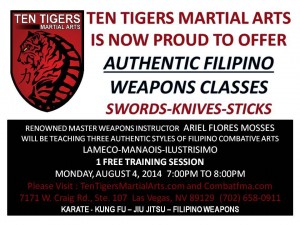
Guro Ariel Flores to teach Mosses Kali, Arnis & Eskrima at Ten Tigers Martial Arts, Las Vegas … [Read more...]
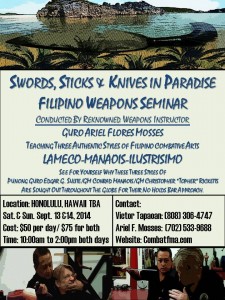
Guro Ariel Flores Mosses Seminar in Honolulu, Hawaii, Saturday, September 13th & 14th, 2014 Announcing the upcoming seminar in Honolulu, Hawaii September 13 & 14, 2014. Please check out our exciting new website at www.combatfma.com designed by humaninterestvideoproductions@gmail.com \ … [Read more...]
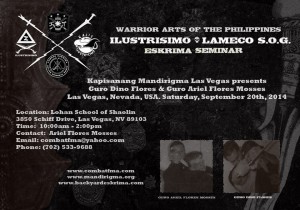
Kapisanang Mandirigma Las Vegas Presents presents Guro Dino Flores and Guro Ariel Flores Mosses Seminar in Ilustrisimo & Lameco Eskrima. Las Vegas, Nevada, Saturday, September 20th, 2014 Guro Dino and Guro Ariel have been training partners since the 1980′s. They first began teaching seminars together in the 1990′s in Wahington State, Oregon, Nevada and California. About Guro Ariel: Guro Ariel F. Mosses has over 30 years of Filipino Martial Arts experience. He has trained under Filipino Hall of Fame Grand Master Conrad A. Manaois, the late Punong Guro Edgar G. Sulite, and Grand Master Christopher Ricketts of Kali Ilustrisimo. Guro Mosses is the Vice President and Chief Instructor for Manaois Systems International. He holds a 7th degree in Kali Jukune Do. Guro Ariel is a member of Kapisanang Mandirigma. He has experience as a professional bodyguard and is a former police officer. Guro Ariel is currently teaching at LV Tactical Training in Las Vegas, Nevada. About Guro Dino: Guro Dino trained for many years with Grandmaster Conrad A. Manaois in Ninoy Cinco Teros Arnis and Master Henry Bio in Sikaran Arnis in the 1980′s along with his cousins Ariel Flores Mosses and Choy Flores. In the early 1990′s he was accepted as an initial member of Punong Guro Edgar Sulites’ newly forming Backyard Group AKA the Sulite Oriehenal Group At the recommendation of Punong Guro Sulite, Guro Dino first visited Master Christopher Ricketts in the Philippines in 1995 and was introduced to his perspective on the Warrior Arts. Since the passing of Punong Guro Sulite, he has continuously train in Kali Ilustrisimo Under Master Christopher Ricketts, who gave Guro Dino permission to teach his method before his passing. Guro Dino was the Lameco representative for Master Ricketts and a member of Bakbakan Philippines sponsored by Master Ricketts. Guro Dino continues his training in Master Ricketts method of training with his two sons, the young Masters Bruce and Guro Brandon Ricketts. Masters Bruce Ricketts and Guro Brandon Ricketts are now officially the head of the late Grandmaster Christopher Ricketts “Ilustrisimo” organization which strives to preserve the purity of the art. Guro Dino additionally had good fortune to experience training in Kali Ilustrisimo with Dodong Sta. Iglesia, Grandmaster Rey Galang, Grandmaster Yuli Romo and Grandmaster Tony Diego. He also trained in Kali Ilustrisimo with one of his training partners and fellow Lameco Backyard member Guro Hans Tan, who was certified to teach Kali Ilustrsimo under Master Tony Diego.Additionally Guro Dino trained privately for several years in California and the Philippines with Professor Ireneo L. Olavides in Eskrima De Campo JDC-IO. Guro Dino also cites the importance of his training partners in Lameco SOG and Kapisanang Mandirigma in his growth. After the passing of Punong Guro Edgar Sulite, certain members of the Lameco Backyard group reformed also became know as Kapisanang Mandirigma. The group regularly continued training, sparring, experimenting and seeking the deeper roots of their chosen arts. This group includes Guros Joel Adriatico, Hospecio “Bud” Balani Jr., Mar Elepaño, Choy Flores, Arnold Noche, Gary Quan, Hans Anton Tan and Pantaleon “Mang Leo” Revilles, Jr. (RIP). With frequent visits by Guro Lowell Pueblos, Guro Bong Hebia and honorary member Guro Ariel Flores Mosses. … [Read more...]
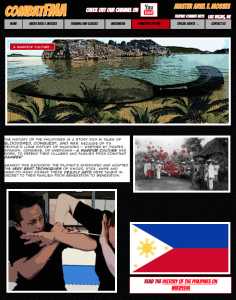
Guro Ariel Flores Mosses: About Guro Ariel: Guro Ariel F. Mosses has over 30 years of Filipino Martial Arts experience. He has trained under Filipino Hall of Fame Grand Master Conrad A. Manaois, the late Punong Guro Edgar G. Sulite, and Grand Master Christopher Ricketts of Kali Ilustrisimo. Guro Mosses is the Vice President and Chief Instructor for Manaois Systems International. He holds a 7th degree in Kali Jukune Do. Guro Ariel is a member of Kapisanang Mandirigma. He has experience as a professional bodyguard and is a former police officer. Guro Ariel is currently teaching at LV Tactical Training in Las Vegas, Nevada. Guro Ariel will be one of the instructors at Jeff Speakman’s 5.0 Fighter Event Las Vegas, Nevada, USA. June 27, 28, 29 – 2012. To contact Guro Ariel go to: http://combatfma.com/index.html … [Read more...]
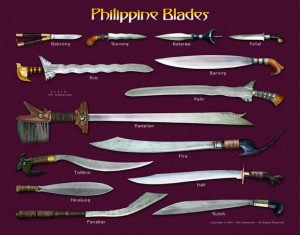
Illustration: Various Philippine Blades … [Read more...]
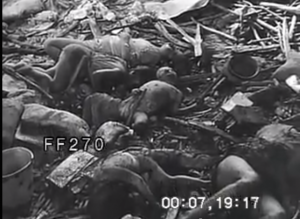
http://youtu.be/NtR4UTFQOGM A month after the 1st Cavalry Division arrived in the Philippines, the battle for Manila’s liberation finally met its conclusion. The wrath of war resulted to the deaths of 100,000 Filipino civilians and the destruction of stunning landmarks that once made Manila the Pearl of the Orient. In 1995, a monument called the “Memorare-Manila 1945” was placed at Plazuela de Sta. Isabel in Intramuros to remember this dark chapter in country’s history. The inscription, which was penned by National Artist Nick Joaquin, says that “This memorial is dedicated to all those innocent victims of war, many of whom went nameless and unknown to a common grave, or never even knew a grave at all, their bodies having been consumed by fire or crushed to dust beneath the rubble of ruins.” From: http://www.filipiknow.net/rare-historical-videos-philippines/ … [Read more...]

http://youtu.be/RzmE8H5wiC8 Battle of Manila (1945) The month-long Battle of Manila in 1945 was one of the bloodiest moments of WWII, killing at least 100, 000 Filipino civilians who were either bombed or bayoneted–some were even burned alive. It all started when the American forces led by Field Marshal Douglas MacArthur arrived in Manila in January 1945. Their initial goals were to liberate Allied civilians interned at UST as well as seize the Malacañan Palace, which they were able to achieve. Threatened by the advancing American forces, the group under General Tomoyuki Yamashita withdrew to Baguio City. All hell broke loose when Rear Admiral Sanji Iwabuchi refused to surrender and chose to defend the city until death. Historical buildings and bridges were destroyed, Bayview Hotel served as a rape center, and entire row of houses were burned together with their occupants. Thousands of innocent Filipino civilians were killed using the most atrocious of methods–they were massacred with the help of machine guns, katanas, and bayonets. In his book “American Caesar,” author William Manchester wrote that the “devastation of Manila was one of the great tragedies of World War II. Seventy percent of the utilities, 72 percent of the factories, 80 percent of the southern residential district, and 100 percent of the business district were razed… Hospitals were set afire after their patients had been strapped to their beds. The corpses of males were mutilated, females of all ages were raped before they were slain, andbabies’ eyeballs gouged out and smeared on walls like jelly.” From: http://www.filipiknow.net/rare-historical-videos-philippines/ … [Read more...]

The Bolomen of the Revolution by Perry Gil S. Mallari , FIGHT Times Editor Arma Blanca is the name of the clandestine regiment of Filipino bolomen active during the revolution against the Spaniards and the Americans. Arma Blanca is a Spanish singular term for a bladed weapon like a sword or a knife. A fairly recent mention of Arma Blanca was made in Orlino Ochosa’s book Bandoleros: The Outlawed Guerillas of the Philippine-American War of 1903 to 1907 (New Day Publications, 1995), and it reads, “Manila’s Arma Blanca that phantom army of bolomen whom General Luna had so much depended upon in his bold attack of Manila at the start of the war with the Americans.” An earlier reference to Arma Blanca can be found in The Philippines Past and Present, by Dean C. Worcester released in 1914. Worcester, who had served as Secretary of the Interior of the Philippine Islands from 1901 to 1913 and was a member of the Philippine Commission from 1900 to 1913, wrote, “The regiment of Armas Blancas had already been raised in Tondo and Binondo. It was in existence there in December, 1898, and may have been originally organized to act against Spain.” The bolo being both a farm implement and a weapon was carried with impunity by Filipinos even in the presence of Spanish and American soldiers. Its blade is often designed heavily weighted towards the tip for ease of chopping hence when used in combat, it can easily severe a limb with a single stroke. The Philippine bolo boasts of a sturdy construction and minor dents on its blade could easily be fixed by a little hammering and filing. In the absence of guns, the Philippine revolutionary forces greatly depended upon the bolo in inflicting casualty on the enemy. A part of Worcester’s book reads, “There is no reason for believing that this is a complete statement of sandatahan [Filipino armed groups] organized in Manila by the end of January, and yet this statement gives a force of at least 6,330 men. General Otis said that this force had been reported to him as being 10,000 men. It is probably true that only a small number of them had rifles; but armed with long knives and daggers they could have inflicted much damage in a sudden night attack in the narrow and badly lighted streets of Manila.” Filipino bolomen even received precise instructions on how to use the blade in conducting raids to snatch the guns of their enemies. A part of Emilio Aguinaldo’s order to the sandatahan was included in Worcester’s book, and it reads, “At the moment of the attack the sandatahan should not attempt to secure rifles from their dead enemies, but shall pursue, slashing right and left with bolos until the Americans surrender, and after there remains no enemy who can injure them, they may take the rifles in one hand and the ammunition in the other.” Continue reading story at: http://www.manilatimes.net/the-bolomen-of-the-revolution/104227/ … [Read more...]
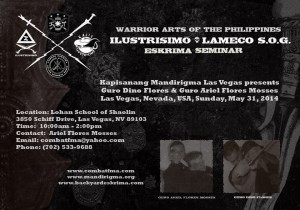
Kapisanang Mandirigma Las Vegas Presents presents Guro Dino Flores and Guro Ariel Flores Mosses Seminar in Ilustrisimo & Lameco Eskrima. Las Vegas, Nevada, Saturday, May 31st, 2014 Guro Dino and Guro Ariel have been training partners since the 1980′s. They first began teaching seminars together in the 1990′s in Wahington State, Oregon, Nevada and California. About Guro Ariel: Guro Ariel F. Mosses has over 30 years of Filipino Martial Arts experience. He has trained under Filipino Hall of Fame Grand Master Conrad A. Manaois, the late Punong Guro Edgar G. Sulite, and Grand Master Christopher Ricketts of Kali Ilustrisimo. Guro Mosses is the Vice President and Chief Instructor for Manaois Systems International. He holds a 7th degree in Kali Jukune Do. Guro Ariel is a member of Kapisanang Mandirigma. He has experience as a professional bodyguard and is a former police officer. Guro Ariel is currently teaching at LV Tactical Training in Las Vegas, Nevada. About Guro Dino: Guro Dino trained for many years with Grandmaster Conrad A. Manaois in Ninoy Cinco Teros Arnis and Master Henry Bio in Sikaran Arnis in the 1980′s along with his cousins Ariel Flores Mosses and Choy Flores. In the early 1990′s he was accepted as an initial member of Punong Guro Edgar Sulites’ newly forming Backyard Group AKA the Sulite Oriehenal Group At the recommendation of Punong Guro Sulite, Guro Dino first visited Master Christopher Ricketts in the Philippines in 1995 and was introduced to his perspective on the Warrior Arts. Since the passing of Punong Guro Sulite, he has continuously train in Kali Ilustrisimo Under Master Christopher Ricketts, who gave Guro Dino permission to teach his method before his passing. Guro Dino was the Lameco representative for Master Ricketts and a member of Bakbakan Philippines sponsored by Master Ricketts. Guro Dino continues his training in Master Ricketts method of training with his two sons, the young Masters Bruce and Guro Brandon Ricketts. Masters Bruce Ricketts and Guro Brandon Ricketts are now officially the head of the late Grandmaster Christopher Ricketts “Ilustrisimo” organization which strives to preserve the purity of the art. Guro Dino additionally had good fortune to experience training in Kali Ilustrisimo with Dodong Sta. Iglesia, Grandmaster Rey Galang, Grandmaster Yuli Romo and Grandmaster Tony Diego. He also trained in Kali Ilustrisimo with one of his training partners and fellow Lameco Backyard member Guro Hans Tan, who was certified to teach Kali Ilustrsimo under Master Tony Diego.Additionally Guro Dino trained privately for several years in California and the Philippines with Professor Ireneo L. Olavides in Eskrima De Campo JDC-IO. Guro Dino also cites the importance of his training partners in Lameco SOG and Kapisanang Mandirigma in his growth. After the passing of Punong Guro Edgar Sulite, certain members of the Lameco Backyard group reformed also became know as Kapisanang Mandirigma. The group regularly continued training, sparring, experimenting and seeking the deeper roots of their chosen arts. This group includes Guros Joel Adriatico, Hospecio “Bud” Balani Jr., Mar Elepaño, Choy Flores, Arnold Noche, Gary Quan, Hans Anton Tan and Pantaleon “Mang Leo” Revilles, Jr. (RIP). With frequent visits by Guro Lowell Pueblos, Guro Bong Hebia and honorary member Guro Ariel Flores Mosses. … [Read more...]
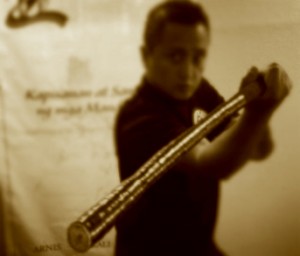
Filipino Martial Arts with guest instructor Ariel Mosses at Green Valley Range in the Fight Room. http://youtu.be/11s-EeaYD6A Filipino Martial Arts with guest instructor Ariel Mosses at Green Valley Range in the Fight Room. This GVR Tacticals class is included in the Club Membership and open to the public. The S.A.F.E. Program (Survive an Attack by Fighting Effectively) is based on Filipino Martial Arts. Utilizing everyday objects like a pen, keys, a rolled up magazine, stick and a knife, Ariel Mosses instructs on basic self-defense techniques. These techniques can be utilized and adapted for different age groups and physical ability. Every month GV Range offers a Skill Building Class called "GVR Tacticals" with guest instructors who specialize in specific self - defense arts. Be sure to like and share our video and stop on by to get some Trigger Time on at Green Valley Range! Stay Safe! Guro Ariel F. Mosses is also an advisor for Mandirigma.org and a founding member of Kapisanang Mandirigma. More information on him at: http://combatfma.com, http://backyardeskrima.com/?cat=43 and http://backyardeskrima.com/?p=858 … [Read more...]
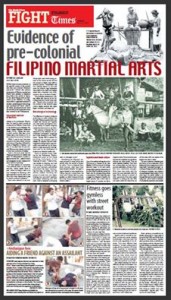
Evidence of pre-colonial FILIPINO MARTIAL ARTS May 25, 2014 12:30 am by Perry Gil S. Mallari FIGHT Times Editor While there is scant mention of the specific names of the martial arts that pre-colonial Filipinos practiced, I believe that various prototypes of Filipino martial arts (FMA) were already in existence long before the arrival of Spain. To me, three things serve as indicators of the existence of indigenous FMA: organized method of warfare, metallurgical technology and sophisticated blade culture. All three aforementioned were chronicled by the Spaniards when they arrived in the Philippines. Organized method of warfareAsdang is the prehispanic Filipino term for hand-to-hand combat as mentioned by William Henry Scott in his excellent book Barangay: Sixteenth-Century Philippine Culture and Society (1994), “Asdang was hand-to-hand combat. Bulu was a duel. Hulaw was a man known to be on the lookout for an enemy,” he wrote. While it may be true that sheer number is the prime factor why the native army of Lapulapu defeated the forces of Magellan in Mactan, I am firm in my stand that the pre-colonial Filipinos were already schooled in their own methods of warfare. Scott in his book wrote that the Visayan general term for warfare was gubat. He distinguished combat engagements into two—gahat (by land) and mangayaw (by sea). Salakay is the word used for attacking.” On land attacks, he comments, “The preferred tactic on land was ambush—habon, saghid, hoom or pool—either by lying in wait or by such strategies as exposing a few agile warriors to enemy view to lure them into a trap. Sayang was to pass by hidden enemies unawares.” Scott even referred to an individual tactic used while being pursued by the enemy as well as how the concept of death could affect a warrior’s psyche, “Pinaorihiyan was for a fleeing warrior to turn and spear his pursuer; naga kamatayan was to fight to the death; and mangin matay was a desperate man determined to die on the field of battle.” Terminologies pertaining to military affairs also abound as the following lines from Scott’s book indicate, “Special roles connected with the conduct of war included away, enemy; bantay, sentinel; bila, allies; kagon, mediator; and laway, spy.” Continue reading article here: http://www.manilatimes.net/evidence-of-pre-colonial-filipino-martial-arts-2/99117/ … [Read more...]
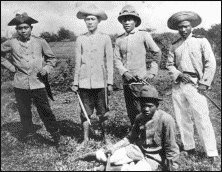
The PBS Film: Crucible of Empire - The Spanish American War One hundred years ago, United States celebrated victory in the Spanish-American War. Popular songs and headlines popularized Commodore Dewey's victories at sea and Theodore Roosevelt's ride up Kettle Hill. Although the Spanish-American War sparked unprecedented levels of patriotism and confidence, the defeat of the Spanish also raised new questions about the nation's role as a world power. CRUCIBLE OF EMPIRE: THE SPANISH-AMERICAN WAR, narrated by award-winning actor Edward James Olmos, examines the colorful characters and historic events surrounding this 100-year-old war and its relevance to the twentieth century. When a declining Spain, beset by rebellion abroad, fell to American expansionism, the United States inherited her colonies and suddenly emerged as a world power. The experience and questions that the Spanish-American War raised about foreign intervention echo throughout the 20th century—as recent events in Kosovo show. Even in its own time, the war with Spain was understood as a turning point in American history. As the twentieth century ends, it is instructive to note the complexities and significance of this very brief war that began this century. In the words of noted historian Walter LaFeber, "The 1898 war literally as well as chronologically ushered in the United States as a major shaper, soon the major shaper, of twentieth-century world politics and commerce." In the process, it also unified a nation still embittered by Civil War divisions; debuted the media in its role as catalyst of U.S. intervention; built up the navy and inspired a re-evaluation of the army; and vastly broadened the powers of the president in wartime and foreign affairs. Clearly, the Spanish-American War was more than the war that ended the nineteenth century; it was also the war that launched the American century. Using original footage and period photographs, newspaper headlines, more than a dozen popular songs from the 1890s, and interviews with some of America's most prominent historians, CRUCIBLE OF EMPIRE tells how issues of race, economy, technology, yellow journalism, and public opinion propelled America into this war. Four 1990s Senators bring to life the 1899 Senate debate on imperialism: Patrick Leahy (VT), Frank Lautenberg (NJ), Paul Simon (IL), and Alan Simpson (WY). The film also features Larry Linville (Major Frank "Ferret Face" Burns of "M*A*S*H") as the voice of Rough Rider Theodore Roosevelt, Laurence Luckinbill as President William McKinley, and Lou Diamond Phillips as Philippine revolutionary Emilio Aguinaldo. Continue reading at: http://www.pbs.org/crucible/film.html https://www.youtube.com/watch?v=8g8NpQsmxj4 http://youtu.be/8g8NpQsmxj4 … [Read more...]
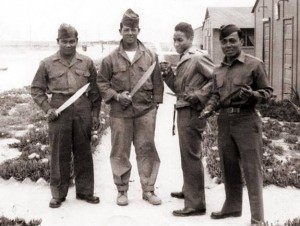
Eskrimadors in the Korean War Philippine Army soldiers in South Korea display their bladed weapons (the Bolo) which they used in silently killing Chinese and North Korean sentries or during hand to hand fighting. The Filipino soldiers earned a well-deserved reputation in the Korean War as brutally efficient in killing the enemy soldiers with their bolos. The Philippine Expeditionary Force to Korea (PEFTOK): 1950-1955 THE KOREAN WAR, which began 63 years ago on 25 June 1950, remains a"Forgotten War" for most of today’s 100 million Filipinos. Hardly surprising in a country where three out of four persons is 35 years old or younger. But for the 7,420 officers and men of the Philippine Army that served in Korea from 1950 to 1955, and for those who actively supported our fighting men, the Korean War was probably the defining event of their lives. From 1950 to 1955, five Battalion Combat Teams (BCTs) of the Philippine Army served in Korea as the elite PHILIPPINE EXPEDITIONARY FORCE TO KOREA orPEFTOK. PEFTOK’s mission was to defend the Republic of Korea against communist conquest. Continue at: http://peftok.blogspot.com More about the Korean War at Office of the Historian, Bureau of Public Affairs, United States Department of State http://history.state.gov/milestones/1945-1952/korean-war-2 … [Read more...]
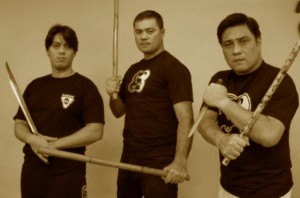
Grandmaster Antonio "Tatang" Ilustrisimo Introduction to Kalis Ilustrisimo with Bakbakan Senior Instructor - Doran Sordo. Introduction to Kalis Ilustrisimo. Covering basic strikes, body mechanics, combative ranges, footwork, blade drills and defense, and Punta y Daga or sword and dagger. Kalis Ilustrisimo is the blade art or system of the late Grand Master Antonio Ilustrisimo. Brought to you by Bakbakan Combat Arts International Senior Instructor -Doran Sordo. Dates to be announced for May, 2014. Demo class tomorrow at The Vessel, Mandala Spa & Villas. — at The Vessel, Mandala Spa & Villas. Boracay, Philippines This seminar is not to be missed! Bakbakan Combat Arts International Senior Instructor - Doran Sordo sharing Kalis Ilustrisimo! Just in case you need more convincing, the seminar is in Beautiful Boracay. Be there! Date in May to be announced. Proceeds go to Grandmaster Tony Diego's medical fund. More Information: http://facebook.com/doransordo Training with Master Christopher Ricketts in Makati, Philippines. Training with Master Tony Diego in Luneta Park, Philippines. Training session with Bakbakan Brothers Monsour del Rosario and Miguel Zubiri in Manila, Philippines. … [Read more...]
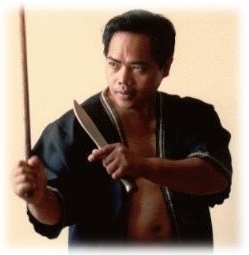
Lameco Eskrima is the system of Filipino martial arts founded by the late Punong Guro Edgar Sulite Lameco Eskrima is the system of Filipino martial arts founded by the late Punong Guro Edgar Sulite based on his training and experience with various Philippine Martial Arts masters, with heavy influence from Jose Caballero and Antonio Ilustrisimo. The word Lameco is actually a combination of words which are the three basic ranges of combat involved in the study and practice of Lameco Eskrima – Largo, Medio and Corto (Long, Middle, close). Contents One of the characteristics of Filipino martial arts is the use of weapons from the very beginning of training. Lameco uses Double and single Stick, Double and single Dagger, Stick and Dagger, Sword, Staff, Handkerchief, and Empty Hands. Lameco Eskrima is a synthesis of five major and six minor systems of Eskrima. Lameco training includes drills called Laban Laro (Play Fighting). Laban Laro allows the escrimador to come as close to real combat as possible without injury. It is also designed to get an uncountable number of repetitions in a short period of time. Through his constant efforts for developing new training innovations, Edgar invented unique armor for the hands and forearms that allowed practitioners to safely train more realistically. History At a young age Edgar Sulite’s father exposed him to the Filipino Martial Arts, himself being a boxer and Arnisador. Growing up in the Barrios of the Philippines, Edgar witnessed many skirmishes settled blade against blade. Edgar trained with martial arts masters who included Leo Gaje of Pekiti-Tirsia, Jose Cabellero of De Campo Uno-Dos-Tres Orehenal, Jesus Abella of Modern Largos, Antonio Illustrisimo of Kali Illustrisimo and many others. In 1981, he moved to Manila to train under Grandmaster Antonio Ilustrisimo. After relocating to the United States on June 30, 1989. … [Read more...]
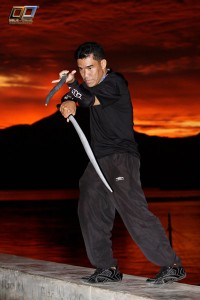
Kalis Ilustrisimo in Colorado!!!! June 21-29, 2014 Denver and Estes Park, Colorado. Kapatiran Mandirigma is proud to announce the only appearance in the United States for Kalis Ilustrisimo Senior Instructors Arnold Narzo and Peachie Baron-Saguin. They are direct students of the Living Legend in the Philippines, Grandmaster Tony Diego of Kalis Ilustrisimo. Grandmaster Tony Diego is the top disciple of Grandmaster Antonio ‘Tatang’ Ilustrisimo and is continuing Tatang’s legacy through his Kalis Ilustrisimo Repeticion Orehenal. Do not miss this once in a lifetime chance to train with a legend! We are hosting a week’s worth of training in Colorado. June 21-22. 2 Day Seminar in Denver. Everyone is welcome to attend. Beginners or experts. Cost – Pre-Registration. $150 for 2 days and $90 for one day. Pre-Registration is Deadline May 17th. After May 17th, $180 for 2 days, $110 for one day. Location - Northglenn Rec Center. http://goo.gl/maps/cepWE Time – 9am-4pm with a one hour lunch. June 23-25. Private Training during the week GM Tony and his assistants will train you in a small group, or privately. Openings are limited, so please reserve your spot soon. We will have two days worth of private lessons in Denver and one day in Longmont. Locations of the private training will be announced to those who reserve spots. Cost - $150 for a 4-5 hour session. June 27-29. Kapatiran Mandirigma Camp in Estes Park. Please go here for the official Event Page -> https://www.facebook.com/events/443936922405914/ KM will host their yearly camp in Estes Park. This year, we will have Peachie Baron and Arnold Narzo teaching. We will also have a few special guest instructors. The camp is held on private land with cabins with bunk beds, lodge house with kitchen and entertainment area and acres of wilderness to explore. The camp is only a few minutes from old town Estes Park and many hotels and lodges. Camp lodging is limited to 25 persons. Camp attendance is limited to 40 persons. Location and schedule will be provided to those who reserve a spot. Cost – Pre-Registration. $180 for the whole camp. (which includes lodging, training and meals). $100 for Saturday only. Pre-Registration Deadline is May 17th. After May 17th, $220 for the whole camp and $110 for Saturday. If you attend both the Denver Seminar and the KM Camp, you will receive a 10% Discount. For more information, please email Shelley Millspaugh at sanduko@gmail.com We are only taking payments by Paypal or Money Order. To send your payment through Paypal, send to dan@theacademyofma.com with a description of what you are paying for (seminar, privates, camp). If sending a Money Order, please make it out to 'The Academy of martial Arts'' and send to: Dan Lowman 20210 West Sycamore Drive Spring Hill, KS 66083 Sponsored by Kapatiran Mandirigma, U.T.A.M.A. and Archipelago Sandata. … [Read more...]
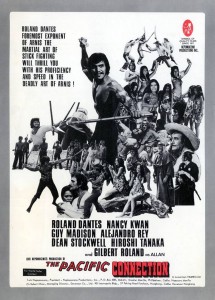
Roland Dantes plays an avenging hero, who defeats the forces of oppression with the power of Arnis! Roland Dantes plays Ben, a farm boy who comes into conflict with the Evil Spanish Governor and his two sons. One of the sons is played by a young Dean Stockwell. To assist in their oppression the Governor hires a Samurai played by Hiroshi Tanaka to teach his son the Japanese Katana sword. To counter this, Ben studies under a blind Franciscan monk to obtain some advanced fighting secrets and develop his warrior senses. Additionally Ben must search for the legendary “Iron Reed”. A mystical stick so strong that grows in the lava of an active Volcano. One of the first full length movies featuring the Philippine Warrior Arts. A must see for any Filipino Martial Arts practitioner. Made in a similar spirit of the “Kung Fu” movies coming out of Hong Kong at the same time in the 1970′s. The fight scenes were choreographed by Professor Remy Presas himself and is jam packed with Arnis inspired fight scenes. Dean Stockwell learned Arnis for his role and continued his Arnis practice long after the filming was over. The success of this movie led to a follow up film “Arnis: Sticks of Death” in 1984 also starring Roland Dantes. Director: Luis Nepomuceno Country: Philippines Language: English Release Date: 1974 (Philippines) Stars: Roland Dantes, Dean Stockwell, Hiroshi Tanaka, Nancy Kwan, Guy Madison, Alejandro Rey, Gilbert Roland, Elizabeth Oropesa, Fred Galang, Gloria Sevilla, Vic Diaz, Cole Mallard … [Read more...]
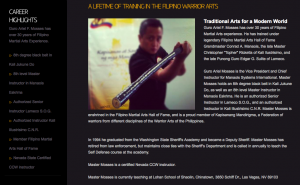
Guro Ariel Flores Mosses: About Guro Ariel: Guro Ariel F. Mosses has over 30 years of Filipino Martial Arts experience. He has trained under Filipino Hall of Fame Grand Master Conrad A. Manaois, the late Punong Guro Edgar G. Sulite, and Grand Master Christopher Ricketts of Kali Ilustrisimo. Guro Mosses is the Vice President and Chief Instructor for Manaois Systems International. He holds a 7th degree in Kali Jukune Do. Guro Ariel is a member of Kapisanang Mandirigma. He has experience as a professional bodyguard and is a former police officer. Guro Ariel is currently teaching at LV Tactical Training in Las Vegas, Nevada. Guro Ariel will be one of the instructors at Jeff Speakman’s 5.0 Fighter Event Las Vegas, Nevada, USA. June 27, 28, 29 – 2012. To contact Guro Ariel go to: http://combatfma.com/index.html … [Read more...]
David Gould discusses comparing Spanish fencing Influence on the local Warrior Arts in both Mexico and the Philippines When comparing the results of Spanish Influence in both Mexico and the Philippines, there is a distinct difference between Filipino Sword Play (Eskrima; indigenous Filipino / Spanish Fencing influence) and Mexican Swordplay (Esgrime; Pure Spanish fencing not mixed with indigenous fighting arts). The Filipino version is quite different as it adopted a lot of the native Filipino practices at the time (1521 - 1898) and the Mexican style remained very much Spanish with Espada-y-daga and Cape and sword technique being brought to the forefront by the Doms and Nobles who were placed in charge of Mexico during its centuries of evolution. Compare the style of "Zorro" from Alta California fame (Mexico) with "Tatang" Ilustrisimo of kalis Ilustrisimo fame and you will get a better idea of what I am referring as there is a distinct difference even though the common thread for both seems to be Spanish Fencing. You can look at the two which were both influenced equally centuries back by the very same Spanish Sword play but each has a different result and appearance to them today. This is significant to the influences which were in each area before the Spanish arrived, native Filipinos in the Philippines and Aztec and Maya in Mexico. Spanish Swordplay was mixed with Filipino Martial Arts in its evolution in the Philippines which resulted in a hybrid of sorts but it remained pure in Mexico not being mixed with the fighting systems of the Mejica (Aztec) which seemed to have not survied in Mexico after Hernan Cortes and his conquistadors defeated that culture in the 1520`s in what is now Mexico City. Through the 1800`s in Mexico this was very obvious regarding the many duels fought in Mexico City with Sword play which had the appearance of remaining pure Spanish fencing. So with all things being equal you should not see any differences in the Spanish Fencing which influenced both Mexico (1519) and the Philippines (1521) but you do and this is because of pre-hispanic fighting methodology which existed in both geographical locations before Spanish Fencing reached the shores of either of the two cultures. Other wise you would not be able to see a distinct difference between Spanish Fencing as it was influenced equally in Manila and Mexico City as both would have the same appearance today as it would have been allowed to remain pure in both cultures equally. But it did not, so there had to have been an Indigenous Filipino component which influenced the evolution in the Philippines, hence the difference in concept, application and appearance yet still showing some Spanish influence and the usage of Spanish names with-in its curriculum regarding numerous fighting styles in the Philippines. When the Spanish invaded the Phiippines in 1521 they did so from Cebu, North to Manila and there was a lot of territory where native Filipinos lived who never saw a Spaniard or their influence. But the question remains for how long? Until the 1600`s? 1700`s? 1800`s? At some point in time the influence would have had to travel south into Mindanao and other areas where Spanish influence had not been felt or experienced before if only minimal by travelers or fishermen who ventured from Mindanao and those areas to other parts of the Philippines and then those influences could have been taken back with them to Mindanao. You are right, there are a lot of things found in the Filipino Warrior Arts regarding weapons, strikes, angles, footwork, etc... which are not found in Spanish Fencing from the 16th Century. So like I stated in my post above you have to come to the conclusion that there were indigenous Warrior Arts in the Philippines before the Spanish invaded at Mactan, but how long were those styles allowed to continue on and flourish unaltered before they were influenced with Spanish methodology, if at all? No one can say with certainty. I am sure that some styles in Mindanao and other areas may have gone generations without mixing the new technology and methodology with the old, but again for how long? It is evident that Spanish Fencing did not mix with the indigenous warior Arts of the Aztec or Maya in Mexico, as well as with the Inka in South America (Peru) because Spanish Fencing remained very pure and unaltered in those areas through out the 19th century and beyond. But this can not be said of the Philippines where the end result is so much different from Spanish Fencing. There clearly was another dominating influence which is responsible for the evolution in the Philippines. In saying all of the above let me make one thing clear. Regardless of the various influences and evolution regarding the Pilipino Warrior Arts in the Philippines and now around the world I am amazed and in awe by this knowledge and fighting ability. I have been fortunate to have trained in numerous Martial Arts from all around the world … [Read more...]
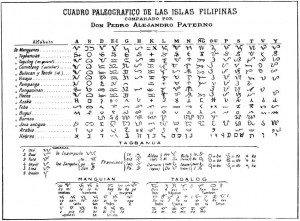
Comparative table of Baybayin variations In the 19th century Pedro Paterno published this comparative table of the various baybayin variations. Baybayin the correct term for our pre-Spanish syllabary not "Alibata". … [Read more...]
Mandirigma.org – Online Since 1998 - A Project of Kapisanang Mandirigma Mandirigma.org Mandirigma Research Organization also known as mandirigma.org is a project of Kapisanang Mandirigma. Their focus includes preserving and promoting the Warrior Arts commonly known as Kali, Eskrima and Arnis. The Warrior Arts is one of the most important aspects of any society because its very nature is to defend and preserve the culture. Thus, mandirigma.org is also involved in researching issues from ancient to current. The primary objective of mandirigma.org is to do its part in keeping alive ancient knowledge and give honor to the sacrifices made by previous generations.Using both traditional and modern methods in its work, mandirigma.org has organized, collaborated with and participated in classes, conferences, demonstrations, festivals, lectures, seminars and workshops with prominent college and community organizations. Aside from their hands-on approach, mandirigma.org utilizes multimedia technologies such as audio, desktop, video and web to reach people across the globe. Researching since the 1970′s and online since 1998, mandirigma.org believes in being actively involved in giving back to the community. They have collaborated with and volunteered in various non-profit agencies. They have also arranged fundraisers in order to assist causes for indigenous tribal groups and organizations dedicated to cultural preservation in the Philippines. mandirigma.org believes that this expansive pursuit is at its best a collaborative effort. This has allowed mandirigma.org to meet and work with many fine individuals and organizations throughout the Philippines, the United States and the world. mandirigma.org welcomes all with an open and positive mind to participate and join them on this never-ending cultural adventure. This humble site is dedicated to honoring the sacrifices of Warriors throughout the many generations that have come before us. Maraming Salamat! … [Read more...]
Mandirigma.org founders Guro Ariel Flores Mosses, Guro Arnold Noche, Guro Bud Balani and Guro Dino Flores mentioned in the Virtual Filipino Martial Arts Museum's "Top 200 Living Guro's" List Exerpt from: http://www.filipinomartialartsmuseum.com/index.htm Welcome to the Filipino Martial Arts Museum, the virtual museum and repository of knowledge of Filipino Martial Arts (FMA) systems, styles, masters, history, literature and virtual artifacts. The writing ranges from incisive to light-hearted to even controversial, and the literary and virtual exhibits encompass all aspects of Filipino martial arts systems and disciplines including arnis, kali, eskrima, dumog, buno, hilot and other indigenous arts of the Philippines. Authors are well-known experts in their fields as well as volunteer writers. Article submissions are encouraged. The authors of these articles have consented to have their articles reprinted and republished in whole or in part, as long as the author’s name, website reference address and this website are acknowledged. I would like this site to become the most comprehensive online reader-written encyclopedia on FMA. It is meant to be a contemporary or living as well as an archival museum. Send your submissions for The Top 200 Living Masters, The Top 100 FMA Schools and other FMA Museum Who’s Who series, and then see your submissions published online. We also accept original articles and online book publications. http://www.filipinomartialartsmuseum.com/index.htm http://www.filipinomartialartsmuseum.com/FMA_masters-systems-schools/FMAguros-living-list.html 1 Dino Flores Lameco Los Angeles, CA, USA 2 Hospecio Balani Lameco Los Angeles, CA, USA 3 David Gould Lameco 4 Leonard Trigg Lameco 5 Arnold Noche Lameco Los Angeles, CA, USA 6 John Jacobo Bakbakan Maryland, USA 7 Roger Agbulos Lameco North Hills, CA, USA 8 Marc Denny Dog Brothers CA, USA 9 Eric Knauss Dog Brothers CA, USA 10 Tim Hartman Modern Arnis USA 11 Kelly Worden Modern Arnis WA, USA 12 Myrlino Hufana Modern Arnis WA, USA 13 Jeffrey Delaney Modern Arnis Canada 14 Randi Schea Modern Arnis 15 Jay de Leon Modern Arnis, Los Angeles, CA, USA 16 Alvis Solis Seneres Arnis TX, USA 17 Ron Balicki Inosanto Kali Los Angeles, CA, USA 18 Diana Balicki Inosanto Kali Los Angeles, CA, USA 19 Ramon Rubia San Miguel Eskrima CA, USA 20 Mel Lopez Villabrille-Largusa 21 Greg Alland Dekiti-Tirsia-Siradas 22 Mary Ann Presas Modern Arnis San Pablo, CA, USA 23 Demetrio Presas Modern Arnis San Pablo, CA, USA 24 Remy Presas, Jr. Modern Arnis San Pablo, CA, USA 25 Tom Bolden Modern Arnis NY, USA 26 Jerome Barber Modern Arnis NY, USA 27 Percival “Val” Pableo Doce Pares 28 Graciella Casillas CA, USA 29 Raffy Pambuan Pambuan Tulisan Arnis FL, USA 30 Steven Dowd Arnis Balite Fallon, NV, USA 31 Hock Hochheim Modern Arnis, Kombatan TX, USA 32 Jorge Penafiel Balintawak Cincinatti, OH, USA 33 Larry Alcuizar Doce Pares Los Angeles, CA, USA 34 Felix Valencia Lameco Santa Barbara, CA, USA 35 Anthony Davis Cabales Serrada CA, USA 36 Sultan Uddin Cabales Serrada CA, USA 37 Darren Tibbon Cabales Serrada CA, USA 38 Jason Inay Inayan Eskrima San Jose, CA, USA 39 Jena Inay Inayan Eskrima San Jose, CA, USA 40 Ray Dionaldo Sayoc Kali FL, USA 41 Edwin Mosqueda Doce Pares 42 Nate Defensor Doce Pares Chicago, IL, USA 43 Conrado Manaois Manaois Eskrima Los Angeles, CA, USA 44 Dan Anderson Modern Arnis WA, USA 45 Rocky Pasiwk Modern Arnis 46 Ron Harris Original Filipino Tapado New Orleans, LA, USA 47 Tim Waid Pekiti-Tirsia TX, USA 48 Leslie Buck Pekiti-Tirsia TX, USA 49 Erwin Ballarta Pekiti-Tirsia TX, USA 50 Gaudencia Ruby Comjuka TX, USA 51 Phil Rapagna Lameco, Inosanto Kali Los Angeles, CA, USA 52 Victor Gendrano Inosanto Kali Los Angeles, CA, USA 53 Stephen Aron Inosanto Kali Glendora, CA, USA 54 Menandro “Anding” de Leon Arnis de Leon Garland, TX, USA 55 Jaime Abregana Hawaii, USA 56 Vincent Cabales Cabales Serrada CA, USA 57 Vincent Cabales, Jr. Cabales Serrada CA, USA 58 Carlito Bonjoc Mata sa Bagyo CA, USA 59 Mark Wiley Cabales Serrada 60 Tom Bisio San Miguel Eskrima 61 Rafael Kayanan Sayoc Kali 62 Tom Kier Sayoc Kali 63 Jeff Chung Sayoc Kali 64 Paul Vunak Inosanto Kali CA, USA 65 Burton Richardon Inosanto Kali HI, USA 66 Steve Grody Lameco 67 Steve Tarani 68 Blaise Loong 69 Cass Magda CA, USA 70 Rick Tucci Inosanto Kali Princeton, NJ 71 James A. Keating Comtech Walla Walla, WA, USA 72 Ed Goco Galang Las Vegas, NV, USA 73 Michael Replogle Modern Arnis USA 74 Felix Roiles Doce Pares Los Angeles, CA, USA 75 Spencer Gee Pananandata NY, USA 76 Bruce Ricketts Kali Ilustrisimo San Diego, CA, USA 77 Maurice Gatdula CA, USA 78 Mar de Leon Tumba-tumba Arnis San Diego, CA, USA 79 Chris Siangco Pedoy Derobio Eskrima San Diego, CA, USA 80 Ernie Reyes, Jr. San Jose, CA, USA 81 Alex France Kombatan CA, USA 82 Alex Ercia Kombatan CA, USA 83 Arthur Gonzalez De Cuerdas Stockton, … [Read more...]

Over the course of the last month, the Philippines has been rocked by a series of natural disasters. First was the 7.2 magnitude earthquake that destroyed homes, many historical churches, and buildings on the islands of Cebu and Bohol. And the most recent, super Typhoon Yolanda (Haiyan), cut a path of destruction through our island nation and other parts of Southeast Asia. Yolanda (Haiyan) has been declared the most powerful typhoon to make landfall in recorded history. The US Navy Joint Typhoon Warning Center stated that at its height, the storm produced sustained winds around 319kph (198mph) with gusts topping out at 379kph (235mph). The final details of fatalities, injuries, and property damage are yet unknown as many areas were left without power and are out of communication with emergency management services. This is a public event open to anyone wishing to learn the foundational concepts and principles of the Filipino Martial Arts. Guro David Gould of Lameco Eskrima, Guro Viko Perrine, and Guro Jerome Teague will be taking participants through some of the fundamentals of their respective systems including: sword, stick, knife, empty, hands, and weapon disarming. This will be an amazing gathering and will benefit a worthy cause. To register, please contact Guro Jerome Teague at (615) 319-3992. Cost is $40 with ALL proceeds going to the Philippine Red Cross. We will also be taking donations of clothing and other essential items. More Info at: https://www.facebook.com/events/169367563261944/ … [Read more...]
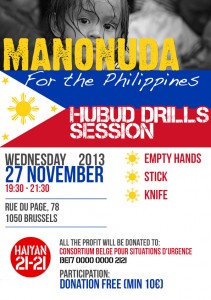
Join our semianr in aid to the Philippines. All the profit will be donated here: http://www.1212.be/fr/haiyanfr/actualites-haiyan/item/5358-encourageant … [Read more...]
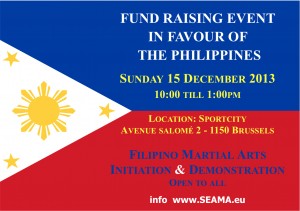
South East Asian Martial Arts Martial Arts Research Systems Belgium - Fund Raising Event in favour of the Philippines Typhoon Victims, Brussels, Belgium. December 15th, 2013. We are all doing Filipino Martial Arts and thus are directly connected to the Filippins. I am setting up an event to support the victime of the Hayian Typhon that causes huge damage in the Filipins recently. I would ask all of my Martial Arts friends to relay the information of the event. The goal of the event is to raise a maximum of funds, During the event your will have the opportunity to train Filipino Martial arts technique and see some demontration. The event is open to all, practicioner as non martial arts practicioner. To be able to join this event, it will be requested that the particpants to give a donation of 15€ minimum directly to the NGO "Action Against Hunger" & "Philippine Red Cross" or any other NGO actively involved in helping the Filipinos victimes. The reason we have choosen "Action Against Hunger" & "Philippine Red Cross" as main NGO, we know from friends who are currently linving in the Philipines that those NGO's are active all the year long doing concret actions. All donations given to any other NGO's are of course welcome. Minimum participation is fixed at 15€ To register send your details and a copy of the proove of payment at info@seama.eu The proof of payement will be the ticket entrance. Minimum participation is fixed at 15€ for a 3hours event. Web Site : Philippine Red Cross: http://www.redcross.org.ph/donate Action Against Hunger: http://www.actionagainsthunger.org/take-action/donate Many thanks for your involvment https://www.facebook.com/events/185510098307114/ http://www.seama.eu/a … [Read more...]
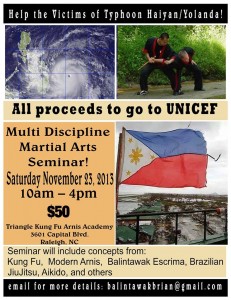
A "Foundations" Seminar -a multi disciplinary day of learning martial arts such as BJJ, Balintawak, Modern Arnis, Aikido, and other arts by some of the most talented instructors in the Carolinas. All proceeds will be donated to UNICEF to aid the families in need during this crisis. https://www.facebook.com/events/430164680418042/?ref_newsfeed_story_type=regular … [Read more...]
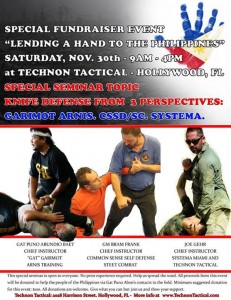
Please join us for this full day seminar where you will get a chance to explore the topic of KNIFE DEFENSE from 3 different perspectives: GARIMOT ARNIS, CSSD/SC and Russian Martial Art SYSTEMA. Presenters: Gat Puno Abundio Baet (Chief Instructor "GAT" Garimot Arnis Training), GM Bram Frank (Chief Instructor Common Sense Self Defense Street Combat) and Joe Gehr (Chief Instructor of Systema Miami and Technon Tactical). All proceeds for this event will go to benefit the people of the Philippines via direct contact of Gat Puno Abon on the field. Min. suggested donation for this event $100. All donations are welcome. Give what you can but join us and show your support. More information will be posted here soon. SAVE THE DATE and SPREAD THE WORD. … [Read more...]
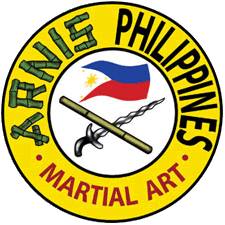
Arnis Philippines OPERATION TULONG FOR ARNISADORS Arnis Philippines Inc. (ARPI) organized “Operation Tulong” for ARPI members who had been victims of super typhoon “Yolanda”. Directors Med Quiambao and Rene Pronstroller were tasked to monitor the donations. President Raymond Velayo said that all donations nationwide shall go directly to the victims. Their names, contact numbers and area are as follows: 1. Arnis GM Carlito Ondillo 0921-5226327 Capiz Province 2. Glerio Urmeneta 0949-6958970 Tacloban City * Others to follow Please give us your full name and the victims name and donation given for posting inwww.arnisphilippines.com and arnisphilippines. Thank you for whatever assistance that you will give. Please continue to pray for all the victims of the typhoon and may God always bless you! … [Read more...]
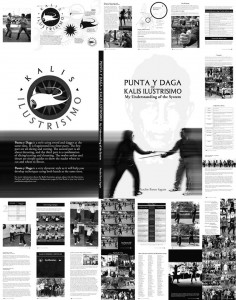
Kalis Ilustrisimo Book by Guro Peachie Baron Saguin on Punta y Daga to be released early 2014 What Is It Like to Train with the Master of Kalis Ilustrisimo? By: Peachie Baron-Saguin Submitted by: Steven Dowd I first met Master Tony Diego when I joined Bakbakan International in 1989. He was a friend of the Master of Bakbakan Christopher Ricketts, and was invited frequently in our practice sessions, to share with the students of Bakbakan his style in sword and knife fighting. Master Tony Diego When Master Christopher Ricketts left for the States, I started training with Master Diego on a regular basis with his Binondo group, the Kalis Ilustrisimo. My training then took on a leap. I was showed the proper way to hold the blade, not to grip the handle too tight, to prevent it from being disarmed when struck heavily with another sword. I was then taught the different kinds and forms of striking and blocking, and the footwork and stances that goes for each attack and counter attack. I was asked to repeatedly execute a particular strike before moving on to the next. Master Diego has always reiterated the importance of a repetitive exercise for one to gain mastery of the form. Peachie Baron-Saguin training with Master Tony Diego Soon enough Master Diego taught me how to use the stick and knife at the same time. This style is called Puntai y Daga. From this style, my interest grew more and more and I always look forward to a sword play with Master Diego, where my speed and accuracy to block and strike are put to test, my distance and movements, checked and corrected. There are moments when Master Diego would attack me when my guard is down to find out how I would react. If I stopped, he would tell me not to think but just to react, otherwise I get hit. The word “sorry” is never use in the gym. If you get hit, it’s your fault. After considerable drills with a wooden sword, Master Diego gave me as a gift, a real sword to practice on. Again my strikes and counter strikes were checked. Using the real sword, Master Diego would ask me to execute the different strikes and counter strikes. The purpose of this exercise, he said, is to gain better control of the blade and to prevent improper techniques from developing, and thus trains the student to hit at the right angle. My first swordplay using a real sword with Master Diego was really scary, but then I passed with flying colors. Suffice it to say, I was taught not only to defend and attack on a standing position, but on a sitting and lying down position as well. The exercise of ascending and descending the stairs during a duel is so difficult and tiring. Disarming is also part of the drills. Training with Master Diego is not easy. I often find myself catching my breath during the swordplay, while Master Diego is laughing and comfortably attacking and parrying my strikes. At the end of each session, I am totally exhausted. My shoulders ache and I could hardly lift my arms. At home before going to bed, I would take a muscle relaxant to relieve the pain so I could train again in the next session. Master Tony Diego and Tommy Dy Tang (Tom) in action using a bladed bolo or sword in an exhib- ition of Kalis Ilustrisimo. Tom is an instructor of Kalis Ilustrisimo, owner of the gym in Binondo where the group practices. As I continue my training with Master Diego, I am learning not only the art of bladed weapons but also, the essence of a good swordsman, the discipline and the commitment that one must have to the art. … [Read more...]
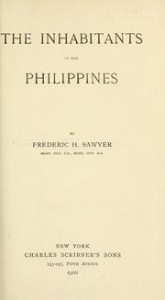
Some of the Combat, Massacres, Rebellions, Disputes And Calamities of the Philippine Islands. according to the Book_ The Inhabitants of the Philippines By Frederic H. Sawyer Memb. Inst. C.E., Memb. Inst. N.A. London Sampson Low, Marston and Company Limited St. Dunstan’s House Fetter Lane, Fleet Street, E.C. 1900 Some of the Combat, Massacres, Rebellions, Disputes And Calamities of the Philippine Islands. 1521. Magellan and several of his followers killed in action by the natives of Mactan, near Cebú; Juan Serrano and many other Spaniards treacherously killed by Hamabar, King of Cebú. 1525. Salazar fights the Portuguese off Mindanao, and suffers great losses in ships and men. 1568. Legaspi’s expedition attacked in Cebú by a Portuguese fleet, which was repulsed. 1570. Legaspi founds the city of Cebú, with the assistance of the Augustinians. 1571. Legaspi founds the city of Manila, with the assistance of the Augustinians. 1572. Juan Salcedo fights the Datto of Zambales, and delivers his subjects from oppression. 1574. Siege of Manila by the Chinese pirate Li-ma-hon with 95 small vessels and 2000 men. The Spaniards and natives repulse the attack. The pirates retire to Pangasinan, and are attacked and destroyed by Juan Salcedo. 1577. War against Mindanao and Joló, parts of which are occupied. Disputes between the missionaries and the military officers who desire to enrich themselves by enslaving the natives, which the former stoutly oppose, desiring to convert them, and grant them exemption from taxes according to the “Leyes de Indias.” They considered the cupidity of the soldiers as the chief obstacle to the conversion of the heathen. The Crown decided in favour of the natives, but they did not derive all the benefits they were entitled to, as the humane laws were not respected by the governors. The Franciscans arrived in Manila. 1580. Expedition sent by Gonzalo Ronquillo to Borneo to assist King Sirela. 1581. Expedition sent by the same to Cagayan to expel a Japanese corsair who had established himself there. The expedition succeeded, but with heavy loss. Expedition against the Igorrotes to get possession of the gold-mines, but without success. The Jesuits arrive in Manila. 1582. Expedition against the Molucas, under Sebastian Ronquillo.[390]An epidemic destroyed two-thirds of the expedition, which returned without accomplishing anything. Great disputes between the encomenderos and the friars in consequence of the ill-treatment of the natives by the former. Dissensions between the Bishop of Manila and the friars who refused to submit to his diocesan visit. Manila burnt down. 1584. Second expedition against the Molucas, with no better luck than the first. Rebellion of the Pampangos and Manila men, assisted by some Mahometans from Borneo. Combat between the English pirate, Thomas Schadesh, and Spanish vessels. Combat between the English adventurer Thomas Cavendish (afterwards Sir Thomas), and Spanish vessels. 1587. The Dominicans arrive in Manila. 1589. Rebellion in Cagayan and other provinces. 1593. Third expedition against the Molucas under Gomez Perez Dasmariñias. He had with him in his galley 80 Spaniards and 250 Chinese galley-slaves. In consequence of contrary winds, his vessel put into a port near Batangas for shelter. In the silence of the night, when the Spaniards were asleep, the galley-slaves arose and killed them all except a Franciscan friar and a secretary. Dasmariñias built the castle of Santiago, and fortified Manila with stone walls, cast a large number of guns, and established the college of Sta. Potenciana. 1596. The galleon which left Manila for Acapulco with rich merchandise, was obliged to enter a Japanese port by stress of weather, and was seized by the Japanese authorities. The crew were barbarously put to death. 1597. Expedition of Luis Perez Dasmariñias against Cambodia, which gained no advantage. 1598. The Audiencia re-established in Manila, and the bishopric raised to an archbishopric. Expedition against Mindanao and Joló, the people from which were committing great devastations in Visayas, taking hundreds of captives. Much fighting, and many killed on both sides, without any definite result. 1599. Destructive earthquake in Manila and neighbourhood. 1600. Great sea combat between four Spanish ships, commanded by Judge Morga, and two Dutch pirates. One of the Dutchmen was taken, but the other escaped. Another destructive earthquake on January 7th, and one less violent, but long, in November. 1603. Conspiracy of Eng-Cang and the Chinese against the Spaniards. The Chinese entrench themselves near Manila; Luis Perez Dasmariñias marches against them with 130 Spaniards. They were all killed and decapitated by the Chinese, who then … [Read more...]
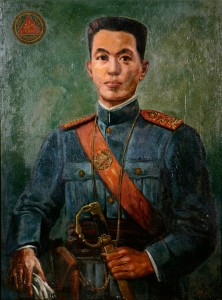
True Version of the Philippine Revolution By Don Emilio Aguinaldo y Famy President of the Philippine Republic. Tarlak (Philippine Islands), 23rd September, 1899 To All Civilized Nations and Especially to the Great North American Republic I dedicate to you this modest work with a view to informing you respecting the international events which have occurred during the past three years and are still going on in the Philippines, in order that you may be fully acquainted with the facts and be thereby placed in a position to pronounce judgment upon the issue and be satisfied and assured of the Justice which forms the basis and is in fact the foundation of our Cause. I place the simple truth respectfully before and dedicate it to you as an act of homage and as testimony of my admiration for and recognition of the wide knowledge, the brilliant achievements and the great power of other nations, whom I salute, in the name the Philippine nation, with every effusion of my soul. The Author. Page 1 The Revolution of 1896 Spain maintained control of the Philippine Islands for more than three centuries and a half, during which period the tyranny, misconduct and abuses of the Friars and the Civil and Military Administration exhausted the patience of the natives and caused them to make a desperate effort to shake off the unbearable galling yoke on the 26th and 31st August, 1896, then commencing the revolution in the provinces of Manila and Cavite. On these memorable days the people of Balintawak, Santa Mesa, Kalookan, Kawit, Noveleta and San Francisco de Malabon rose against the Spaniards and proclaimed the Independence of the Philippines, and in the course of the next five days these uprisings were followed by the inhabitants of the other towns in Cavite province joining in the revolt against the Spanish Government although there was no previous arrangement looking to a general revolt. The latter were undoubtedly moved to action by the noble example of the former.Page 2 With regard to the rising in the province of Cavite it should be stated that although a call to arms bearing the signatures of Don Augustin Rieta, Don Candido Firona and myself, who were Lieutenants of the Revolutionary Forces, was circulated there was no certainty about the orders being obeyed, or even received by the people, for it happened that one copy of the orders fell into the hands of a Spaniard named Don Fernando Parga, Military Governor of the province, who at that time was exercising the functions of Civil Governor, who promptly reported its contents to the Captain-General of the Philippines, Don Ramon Blanco y Erenas. The latter at once issued orders for the Spanish troops to attack the revolutionary forces. It would appear beyond doubt that One whom eye of man hath not seen in his wisdom and mercy ordained that the emancipation of the oppressed people of the Philippines should be undertaken at this time, for otherwise it is inexplicable how men armed only with sticks andgulok1 wholly unorganized and undisciplined, could defeat the Spanish Regulars in severe engagements at Bakoor, Imus and Noveleta and, in addition to making many of them prisoners, captured a large quantity of arms and ammunition. It was owing to this astonishing success of the revolutionary troops that General Blanco quickly concluded to endeavour, to maintain Spanish control by the adoption of a Page 3conciliatory policy under the pretext that thereby he could quel the rebellion, his first act being a declaration to the effect that it was not the purpose of his Government to oppress the people and he had no desire “to slaughter the Filipinos.”. The Government of Madrid disapproved of General Blanco's new policy and speedily appointed Lieutenant-General Don Camilo Polavieja to supersede him, and despatched forthwith a large number of Regulars to the Philippines. General Polavieja advanced against the revolutionary forces with 16,000 men armed with Mausers, and one field battery. He had scarcely reconquered half of Cavite province when he resigned, owing to bad health. That was in April, 1897. Polavieja was succeeded by the veteran General Don Fernando Primo de Rivera, who had seen much active service. As soon as Rivera had taken over command of the Forces he personally led his army in the assault upon and pursuit of the revolutionary forces, and so firmly, as well as humanely, was the campaign conducted that he soon reconquered the whole of Cavite province and drove the insurgents into the mountains. Then I established my headquarters in the wild and unexplored mountain fastness of Biak-na-bató, where I formed the Republican Government of the Philippines at the end of May, 1897.Page 4 1 A kind of sword—Translator. The Treaty of Biak-na-bató Don Pedro Alejandro Paterno (who was appointed by the Spanish Governor-General sole mediator in the discussion of the terms of peace) visited Biak-na-bató several times to negotiate terms of the Treaty, … [Read more...]

Baybayin - The Ancient Script of the Philippines by Paul Morrow This language of ours is like any other, it once had an alphabet and its own letters that vanished as though a tempest had set upon a boat on a lake in a time now long gone. "To My Fellow Children”, attributed to Jose Rizal, 1869 English translation by P. Morrow The tempest in Rizal's verse struck the Philippines in the 16th century. It was the Spanish Empire and the lost alphabet was a script that is known today as the baybayin. Contrary to the common misconception, when the Spaniards arrived in the islands they found more than just a loose collection of backward and belligerent tribes. They found a civilization that was very different from their own. The ability to read and write is the mark of any civilization and, according to many early Spanish accounts, the Tagalogs had already been writing with the baybayin for at least a century. This script was just beginning to spread throughout the islands at that time. Furthermore, the discovery in 1987 of an inscription on a sheet of copper in Laguna is evidence that there was an even more advanced script in limited use in the Philippines as far back as the year 900 C.E. (See The Laguna Copperplate Inscription) Continue at: http://www.mts.net/~pmorrow/bayeng1.htm … [Read more...]
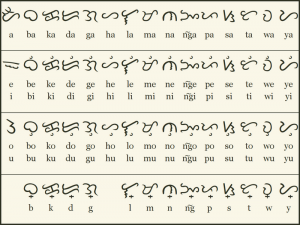
Baybayin: The Lost Filipino Script (Part 1) by Indio Historian The Baybayin as we know it today is an ancient Filipino system of writing, a set of 17 characters or letters that had spread throughout the Philippine archipelago in the sixteenth century. The graphic contours of the Baybayin are distinguished by smoothly flowing curvilinear strokes that convey both suppleness and strength. For some history enthusiasts, never ever ever ever call Baybayin “Alibata”. This name was invented by Paul Versoza who thought that Baybayin came from Arabic and thus named it ‘Alif-bata,’ the first letters of the Arabic script. Recent studies suggest that Baybayin may have come from Sanskrit, the ancient Indian script, brought to the Philippine shores by Indian traders. Where did the name Baybayin come from? The word ‘baybay’ in ancient Tagalog means ‘to spell’ or in modern Filipino, ‘syllable.’ As early as 900 AD, there are tidbits of evidences that the ancients in our islands had a sophisticated way of writing. As to why it quickly disappeared comes from the fact that we were never a print culture like China and Korea, that used paper and built large libraries of scrolls to preserve their history, their memory. Another factor is the effective colonization of Spain by the forcing of the houses of ‘natives’ to be gathered around a town-square called ‘reducciones’ close to the church and the alcaldes for the close supervision of the Spanish authorities. Continue at: http://indiohistorian.tumblr.com/post/13097309564/baybayin-the-lost-filipino-script-part-1-the … [Read more...]
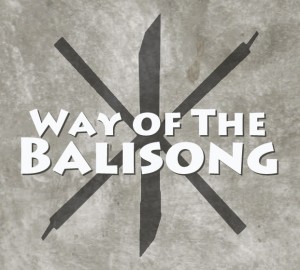
Way Of The Balisong An independent documentary film project that examines the history and culture of the Balisong Knife. BE ON THE LOOKOUT FOR OUR KICKSTARTER CAMPAIGN STARTING SOON!!! Synopsis> From the Batangas region of the Philippines, to the cutlery factories of Oregon-USA, to the practitioners and aficionados connected by the World Wide Web, this film examines the origins, history and culture of the notorious Balisong Knife. Well-known from its appearance in films and popularity among blade enthusiasts, often overlooked is the small town which made the knife famous, now struggling to maintain its identity in a modernizing world. Help Make This Film> The Film is one-third through it's principle completion. Finishing the film will require your help. If you would like to support this project and be a part of history please join our mailing list and follow us on facebook / twitter to stay tuned to announcement for our Kickstarter funding campaign, starting on October 7th. https://www.facebook.com/WayOfTheBalisongwww.wayofthebalisong.comhttps://twitter.com/BalisongMovie Help Make This Film 'Way of the Balisong' is a passion project that started from a visit to the heritage town of Taal, in the Batangas region of the Philippines by filmmaker Paul Factora in 2012. After hearing about the plight of the people in Barangay Balisong and speaking with prominent blade merchant Diosdado Ona about the disappearing industry within the Town it was named after, a decision was made to return and document their story. After 2 subsequent trips to the Philippines, the story expanded. Originally intended as a short 10 minute piece, it became apparent that the tale of the Balisong knife was not relegated to just the Philippines and in order to tell the full story the project must also grow. It wasn't just about a knife, it became about the people who pioneered a craft that spread throughout the world and how that craft is now dwindling away. Along with a couple of friends & cameras one-third of the principle photography was shot in the Philippines completely self funded. Completing the film in it's envisioned entirety, will require another trip to the Philippines and several interviews shot throughout the U.S. 'Way Of The Balisong' will need YOUR help to be completed. Please join our mailing list to recieve updates on our Kickstarter Campaign beginning October 7, 2013 and stay tuned to learn what you can do to help make 'Way Of The Balisong' a reality. http://www.wayofthebalisong.com/about.html … [Read more...]
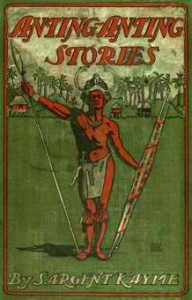
Anting-Anting Stories And Other Strange Tales of the Filipinos By Sargent Kayme Boston: Small, Maynard & Company 1901 [Contents]Copyright, 1901, by Small, Maynard & Company (Incorporated)Entered at Stationers’ HallPress of J. J. Arakelyan Boston, U.S.A.[V] [Contents] Foreword The life of the inhabitants of the far-away Eastern islands in which the people of the United States are now so vitally interested opens to our literature a new field not less fresh and original than that which came to us when Mr. Kipling first published his Indian tales. India had always possessed its wonders and its remarkable types, but they waited long for adequate expression. No less wonderful and varied are the inhabitants and the phenomena of the Philippines, and a new author, showing rare knowledge of the country and its strange peoples, now gives us a collection of simple yet powerful stories which bring them before us with dramatic vividness. Pirates, half naked natives, pearls, man-apes, towering volcanoes about whose summits clouds and unearthly traditions float together, strange animals and birds, and stranger men, pythons, bejuco ropes stained with human blood, feathering palm trees now fanned by soft breezes and now crushed to the ground by tornadoes;—on no mimic stage was ever a more [VI]wonderful scene set for such a company of actors. That the truly remarkable stories written by Sargent Kayme do not exaggerate the realities of this strange life can be easily seen by any one who has read the letters from press correspondents, our soldiers, or the more formal books of travel. Strangest, perhaps, of all these possibilities for fiction is the anting-anting, at once a mysterious power to protect its possessor and the outward symbol of the protection. No more curious fetich can be found in the history of folk-lore. A button, a coin, a bit of paper with unintelligible words scribbled upon it, a bone, a stone, a garment, anything, almost—often a thing of no intrinsic value—its owner has been known to walk up to the muzzle of a loaded musket or rush upon the point of a bayonet with a confidence so sublime as to silence ridicule and to command admiration if not respect. The Editor.[VII] [Contents] Contents The Anting-Anting of Captain Von Tollig1 The Cave in the Side of Coron21 The Conjure Man of Siargao41 Mrs. Hannah Smith, Nurse65 The Fifteenth Wife93 “Our Lady of Pilar”113 A Question of Time131 The Spirit of Mount Apo153 With What Measure Ye Mete179 Told at the Club195 Pearls of Sulu211 [3] [Contents] Anting-Anting Stories The Anting-Anting of Captain Von Tollig There had been a battle between the American forces and the Tagalogs, and the natives had been driven back. The stone church of Santa Maria, around which the engagement had been hottest, and far beyond which the native lines had now been driven, had been turned into a hospital for the wounded Tagalogs left by their comrades on the field. Beneath a broad thatched shed behind the church lay the bodies of the dead, stiff and still under the coverings of cocoanut-fibre cloth thrown hastily over them. The light of a full tropic moon threw the shadow of the roof over them like a soft, brown velvet pall. They were to be buried between day-break and sunrise, that the men who buried them might escape the heat of the day. The American picket lines had been posted a quarter of a mile beyond the church, near which no other guards had been placed. Not long after midnight a surgeon, one of the two [4]men left on duty in the church, happened to look out through a broken window towards the shed, and in the shadow, against the open moonlight-flooded field beyond, saw something moving. Looking close he could make out the slim, brown figure of a native passing swiftly from one covered form to another, and turning back the cocoanut-fibre cloth to look at each dead man’s face. Calling the man who was working with him the surgeon pointed out the man beneath the shed to him. “That fellow has no business there,” he said, “He has slipped through the lines in some way. He may be a spy, but even if he is not, he is here for no good. We must capture him.” “All right,” was the answer. “You go around the church one way, and I will come the other.” When the surgeon, outside the hospital, reached a place where he could see the shed again, the Tagalog had ceased his search. He had found the body he was looking for, and sunk down on his knees beside it was [5]searching for something in the clothing which covered the dead man’s breast. A moment later he had seen the men stealing towards him from the church, had cleared the open space beneath the shed at a leap, and was off in the moonlight, running towards the outposts. The surgeons swore; and one fired a shot after him from his revolver. “Might as well shoot at the shadow of that palm tree,” the one who had shot said. “Anyway it will wake up the pickets, and … [Read more...]

Philippine American War - Advance of Kansas Volunteers at Caloocan by Thomas A. Edison; 5 June 1899 From LibraryOfCongress, Washinton D.C. Comment by Mandirigma.org: At the time of this production, film was a brand new medium. This Film by Thomas Edison shows Filipino Freedom Fighters defending their country against American Invaders. However the director portrays the Filipinos as "Rebels" and the Americans as defenders of "Freedom" and "Liberty" who overcome the "Insurgents". http://youtu.be/_ZjrPU6rPHE SUMMARY From Edison films catalog: From the thick underbrush where the Filipinos are massed comes volley after volley. They are making one of those determined stands that marks Caloocan as the bloodiest battle of the Filipino rebellion. Suddenly, with impetuous rush, Funston's men appear. They pause but for a moment, to fire, reload and fire. The color bearer falls, but the standard is caught up by brave Sergeant Squires and waves undaunted in the smoke and din of the receding battle. This is one of the best battle pictures ever made. The first firing is done directly toward the front of the picture, and the advance of the U.S. troops apparently through the screen is very exciting; the gradual disappearance of the fighters sustaining the interest to the end. 65 feet. $9.75. NOTES Copyright: Thomas A. Edison; 5June1899; 37443. Original main title lacking. Reenacted by the New Jersey National Guard. Materials listed originate from the paper print chosen best copy of two for digitization; for other holdings on this title, contact M/B/RS reference staff. Edison code name (for telegraphic orders): Unbroached. MAVIS 47087; Advance of Kansas Volunteers at Caloocan. Reenacted May 1899 in the Orange Mountains near West Orange, New Jersey. Sources used: Copyright catalog, motion pictures, 1894-1912; Musser, C. Edison motion pictures 1890-1900, 1997; Niver, K.R. Early motion pictures, 1985; Edison films catalog, no. 94, March 1900, p. 4 [MI]; Edison films catalog, no. 105, July 1901, p. 30 [MI]. SUBJECTS United States.--Army.--Kansas Volunteer Infantry Regiment, 20th. Philippines--History--Philippine American War, 1899-1902--Battlefields. Battles--Philippines. Soldiers. Revolutionaries--Philippines. Funston, Frederick,--1865-1917--Military leadership. Battle casualties--Philippines. Flags--United States. War films. Historical reenactments (Motion pictures) Short films. Silent films. Nonfiction films. RELATED NAMES White, James H. (James Henry), production. New Jersey. National Guard. Thomas A. Edison, Inc. Paper Print Collection (Library of Congress) CALL NUMBER FEC 2820 (ref print) FPE 9628 (dupe neg) FPE 9135 (masterpos) LC 973a (paper pos) DIGITAL ID sawmp 0973 http://hdl.loc.gov/loc.mbrsmi/sawmp.0973 … [Read more...]
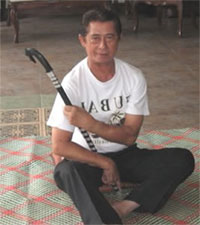
Greetings friends, We are seeking assistance for Master Tony Diego of Kalis Ilustrisimo. Master Diego's wife has breast cancer and has just had surgery for the second time. Sadly, even with surgery it has spread and costly chemotherapy is required. Master Diego is retired from work and has no medical or retirement benefits, so any amount donated will be very much appreciated and put to good use. If you would like to donate you can contact Dino at: mandirigma.org@gmail.com or you can contact Peachie Baron at: peachiebaron@facebook.com … [Read more...]

The Films of Bakbakan Philippines member Ronnie Ricketts and the Warrior Arts of the Philippines Ronnie Ricketts is an actor, film producer and film director in the Philippine Movie and Film Industry. What is less commonly know is that he is a martial artist expert and a Master instructor in the Martial Arts group, Bakbakan International. He is currently the Chairman of the Optical Media Board (OMB), a Philippine Government Agency, which combats piracy of films, music, computer games and software. Ronnie in versed in several forms on Martial arts including the Filipino Warrior Art Kali Ilustrisimo. Ronnie is the brother of Grandmaster Christopher Ricketts the founder of the Martial Arts Brotherhood - Bakbakan International. Several of Ronnie's films feature the Martial Arts including the Warrior Arts of the Philippines generally know as Kali, Arnis or Eskrima. Bakbakan Members frequently appear in Ronnies movies. Ronnies latest movie "The Fighting Chefs". Some scenes feature the Philippines Martial Arts performed by himself and his nephews Bruce and Brandon Ricketts. Bruce and Brandon are Martial Arts experts and instructors in Kali Ilustrisimo. Behind the scence for the movie "The Fighting Chefs. Ronnie with nephews Bruce and Brandons rehearsing some Ilustrisimo Filipino Martial Arts moves for the scene. Ronnie with his brother, Grandmaster Christopher Ricketts. Poster for Mano Mano 3: The Lost Art. Ronnie Ricketts Filmography 2013 The Fighting Chefs 2007 One Percent Full 2006 Lagot Ka Sa Kuya Ko 2005 Uno 2004 Mano Mano 3: Arnis The Lost Art 2003 Utang Ng Ama - Director (Uncredited) 2003 Dayo 2001 Mano Mano 2: Ubusan Ng Lakas 1999 Ang Boyfriend Kong Pari 1999 Desperado, Bahala Na Ang Itaas 1998 May Sayad 1998 My Guardian Debil 1998 Kamandag Ko Ang Papatay Sa 'Yo (Released Date: 4 February 1998) 1998 Anting-Anting 1997 Emong Salvacion 1997 Ilaban Mo Bayan Ko 1997 Wala Ka Ng Puwang Sa Mundo (Released Date: 22 October 1997) 1996 Kahit Sa Bala Kakapit Ako (Released Date: 9 October 1996) 1996 Hawak Ko Buhay Mo (Released Date: 25 September 1996) 1996 Madaling Mamatay, Mahirap Mabuhay (Released Date: 22 May 1996) 1995 Huwag Mong Isuko Ang Laban (Released Date: 25 December 1995) to (1995 MMFF) 1995 Mano Mano 1995 Angel On Fire 1995 Ultimate Revenge 1995 Matinik Na Kalaban (Released Date: 8 November 1995) 1994 Matira Ang Matibay (Released Date: 22 June 1994) 1993 Maton (Directed by: TOTO NATIVIDAD) (Released Date: 24 November 1993) 1993 Pambato (Released Date: 6 October 1993) 1993 Ikaw Lang (Released Date: 25 August 1993) 1993 Alejandro 'Diablo' Malubay (Released Date: 26 May 1993) 1992 Boy Recto (Released Date: 25 December 1992) to (1992 MMFF) 1992 Basagulero (Released Date: 14 October 1992) 1992 Dalawa man ang Buhay mo Pagsasabayin ko (Released Date: 12 August 1992) 1992 Aguila At Guerrero (Released Date: 22 July 1992) 1992 True Confessions (Evelyn, Myrna, & Margie) 1992 Zei Fa Wei Long 1991 Ganti Ng Api 1991 Kumukulong Dugo 1991 Anak ng Dagat 1990 Baril ko ang Uusig (Released Date: 14 November 1990) 1990 Isa-Isahin Ko Kayo (Released Date: 6 June 1990) 1990 Kakampi Ko Ang Diyos (Released Date: 8 May 1990) 1989 My Darling Domestic (Greyt Eskeyp) 1989 Black Sheep Baby (Released Date: 22 November 1989) 1989 UZI Brothers (Released Date: 27 September 1989) 1989 Uzi Brothers 9mm (Released Date: 9 August 1989) 1989 Tatak Ng Isang Api (Released Date: 26 April 1989) 1989 Gapos Gang (Released Date: 22 March 1989) 1988 Alex Boncayao Brigade: The Liquidation Arm Of The Npa 1988 Kumakasa, Kahit Nag-iisa 1988 Tumayo Ka't Lumaban 1988 Target: Maganto 1987 The Rookies And The Mighty Kids 1987 Mga Agila Ng Arkong Bato 1987 Ambush 1987 Target Sparrow Unit 1987 Cabarlo 1987 Kamandag Ng Kris 1986 Payaso 1986 Nakagapos Na Puso 1986 Agaw Armas 1986 Bodyguard: Masyong Bagwisa Jr. 1986 I Love You Mama, I Love You Papa 1986 The Graduates 1986 John En Marsha '86 TNT Sa America 1986 Dongalo Massacre 1985 The Crazy Professor 1985 Heated Vengeance 1984 Sa Hirap At Ginhawa 1983 Love Birds 1983 I Love You, I Hate You 1982 Good Morning, Professor 1982 My Heart Belongs To Daddy Directed by Ronnie Ricketts Rumble Boy (2007) Lagot ka sa kuya ko (2006) (as Ronn Rick) ... aka Isusumbong kita sa kuya ko (Uno (2005) (as Ronn Rick) Mano Mano 3: Arnis, the Lost Art (2004) (as Ronn Rick) Dayo (2003) (as Ronn Rick) Boyfriend kong pari, Ang (1999) (as Ronn Rick) Boy Buluran (1997) (as Ronn Rick) Wala ka nang puwang sa mundo (1997) (as Ronn Rick) Madaling mamatay, mahirap mabuhay (1996) (as Ronn Rick) Produced: Lagot ka sa kuya ko (2006) ... aka Isusumbong kita sa kuya ko (Philippines: Tagalog title) Mano Mano 3: Arnis, the Lost Art (2004) (producer) Wrote: Mano Mano 3: Arnis, the Lost Art (2004) Huwag mong isuko ang laban … [Read more...]
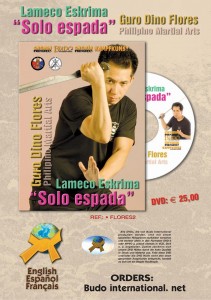
Second Lameco Eskrima DVD featuring Guro Dino Flores released by Budo International This dvd is focused in long distance with the sword, a special training that was heavily influenced by Great Grandmaster Antonio Ilustrisimo. Guro Flores will teach you the differences in strategy in long distance with either stick or sword, the footwork and five of the 12 Eskrima Drills in detail with their applications and variations. Guro Dino Flores has focused this work on long range distance, a distance you must master before venturing into medium or short range distance with any weapon and without protective gear. The 12 Eskrima Drills are a combination of the movements Punong Gruo Sulite found most common in real combat situations and referred to them as the “Soul of Lameco”, because many hidden secrets are found in these apparently simple exercises. Though most of the Eskrima exercises can be done either with stick or sword, this dvd is focused in long distance with the sword, a special training that was heavily influenced by Great Grandmaster Antonio Ilustrisimo. Guro Flores will teach you the differences in strategy in long distance with either stick or sword, the footwork and five of the 12 Eskrima Drills in detail with their applications and variations. These exercises are essential in order to understand the Great Art of Fighting know as Lameco Eskrima. LANGUAGES: ENGLISH. ESPAÑOL, ITALIANO, FRANÇAIS http://www.budointernational.net/296_dino-flores http://youtu.be/kb2291PfCms Information on the first DVD can be found at this link: http://backyardeskrima.com/?p=361 … [Read more...]

Kapisanang Mandirigma and other Eskrima Groups to perform at the 22nd Festival of Philippine Arts and Culture, 2013 in Los Angeles http://fpacpahayag.wordpress.com/2013/05/13/martial-artists/ The iconic festival and annual celebration returns, now in its 22nd year! FilAm ARTS invites you to join us Sep.7-8 at Pt Fermin Park for the largest and longest-running community tradition in Southern California -- the only event where you can see over 500 artists & performers from all over the world entertain you and 25,000 of your closest friends & family! Advance tickets are available at http://fpac22.eventbrite.com/ Whether it's your first time or 22nd, it's always a party at FPAC. Bring everyone you can to the Filipino party of the year! FPAC is produced by FilAm ARTS - the Association for the Advancement of Filipino American Arts & Culture, a non-profit 501(c)(3) organization, and sponsored by the City of Los Angeles, LA County Arts Commission, California Arts Council, National Endowment for the Arts, California Community Foundation, Toyota, The Getty Foundation, LA-18, Mavshack, The Asian Journal, Weekend Balita, BakitWhy.com, Oishi Media, The James Irvine Foundation, and LEAP, Inc. Martial Artists Posted on May 13, 2013 Nick Papadakis Kombat Instruments Ltd. Nick “Pappy” Papadakis has 30 years experience in the martial arts with over 100 fights in the Dog Brothers Gathering of the Pack. Instructor Pekiti Tirsia Kali, Full Instructor Dog Brothers Martial Arts, Blue Belt BJJ, 2nd degree black belt North American Self Defense Institute Kombat Instruments Ltd. is a company created to serve the needs of combat martial artists by providing durable gear for full-contact stick fighting and weapon matches. For more information on Nick or Kombat Instruments Ltd visit www.bloodsport.com ::: Master Joe Tan Modern Tapado Joe feels very lucky and privileged to have trained personally and forged friendship with the original founders of these three Arnis groups that have made their own unique contributions in the propagation of Stick fighting as an Art. He has lot to share with the world. Tapado is an Original Filipino Martial Art which came from a Hiligaynon ( a Filipino dialect) word ‘Tapat’ or ‘Tapos’ which means – finished or done in english.or to finish the job in one strike. For more information visit www.mastertapadoarnis.com ::: Willie Laureano FMA Instructor Guro Willie Laureano is a Kali, Silat, and Kickboxing instructor at Elite Training Center. Willie says, “I am proud to be associated with Elite Training Center where I offer the best in all aspects of the Martial way including physical training respect and confidence.” Willie has lots of Martial Arts training and teaching experience. He has even trained and taught under Guro Dan Inosanto. He has also trained and taught alongside many notable instructors from around the world. Elite Training Center is a martial arts school focusing on self-defense and fitness. Teaching confidence while respecting others, they are founded on the four principals of Respect, Honor, Discipline, and Strength. Techniques include LOTAR®(Close Quarter Battle techniques) and Krav Maga (intuitive self-defense independent of strength or size), Muay Thai kickboxing, Adult Mixed Martial Arts (MMA) as sport, Youth MMA that emphasizes our founding principles, and Kali/Silat/Eskrima (Filipino open hand and stick fighting). For more information visit www.elitetrainingcenter.net ::: Dino Flores The Kapisanang Mandirigma Eskrima Training Institute Guro Dino has taught numerous seminars and classes over the years. He has appeared on Television, Instructional Videos, Independent Film and Radio Shows promoting the arts. He has contributed to magazine article for publications such as “Masters”, “Blitz” and “FMA Digest. Guro Dino has also contributed to book publications including “Masters of the Blade” and “Warrior Arts of the Philippines”. He is currently working on several book and video projects for various masters. Guro Dino has conducted numerous seminars, lectures and demonstrations. Including conferences at UCLA, Cal State Fullerton, University of California Irvine, Loyola Marymount University, Glendale College, Cherry Blossom Festival, Lotus Festival, Philippie Tourism Expo, Sports Expo in Manila, Balintawak Cuentada Gathering Las Vegas and The Festival of Philippine Arts & Culture to name a few. Guro Dino was one of the first instructors invited to the World Filipino Martial Arts Association EXPO in Seattle, Washinton in 1993. One of his proudest moments was to be one of two cultural groups (the othe one being traditional dance) to perform in the world famous Los Angeles City Hall during the televised dedication of the the very first official “Filipinotown” in the USA. Other activities include Guro … [Read more...]

February 28, 1997 By MO1
This article was reprinted with the author’s permission from the Souvenir Edition of Arnisador Magazine published by Goodwill Publications Limited. More information about the magazine can be obtained by calling Peter Morgan in London at +44 (0) 171-895 0800. Saturday, June 1st, 1996 LAMECO: Legacy of Steel By Steve Tarani Swollen knuckles, bleeding forearms and […]
April 10, 1997 By MO1
There is no excerpt because this is a protected post.

January 10, 1998 By MO1
Kapisanang Mandirigma – A federation of warriors from different disciplines of the Warrior Arts of the Philippines. It is not a style, nor a representation of any singular style, but rather a federation of practitioners with similar goals to provide a vehicle for growth and personal discovery through continued training. Founded in 1998 by Guros […]
May 24, 1998 By MO1
Mandirigma.org - Online Since 1998 Mandirigma Research Organization also known as mandirigma.org is a project of Kapisanang Mandirigma. Their focus includes preserving and promoting the Warrior Arts commonly known as Kali, Eskrima and Arnis. The Warrior Arts is one of the most important aspects of any society because its very nature is to defend and preserve […]

February 21, 1999 By MO1
Baybayin Baybayin is a pre-Spanish Philippine writing system. It is a member of the Brahmic family and is recorded as being in use in the 16th century. It continued to be used during the Spanish colonization of the Philippines up until the late 19th Century. The term Baybay literally means “to spell” in Tagalog. Baybayin […]

May 18, 1999 By MO1
Kapisanang Mandirigma founders Guro Ariel Flores Mosses, Guro Arnold Noche, Guro Bud Balani and Guro Dino Flores mentioned in the Virtual Filipino Martial Arts Museum’s “Top 200 Living Guro’s” List Exerpt from: http://www.filipinomartialartsmuseum.com/index.htm Welcome to the Filipino Martial Arts Museum, the virtual museum and repository of knowledge of Filipino Martial Arts (FMA) systems, styles, […]

February 13, 2000 By MO1
Sticks of Death (Arnis: The Sticks of Death) This Filipino Martial Arts action film features Roland Dantes. Dantes plays Johnny Guerrero, a man who masters the ancient art of arnis with the help of his grandfather to get revenge on a group of crooks who attempted to beat him to death. Using two deadly sticks, […]

July 1, 2000 By MO1
The Battle of Manila – Starts with discussion from 2 Vets memories of the WW2 Japanese invasion and internment of civilians to the military incursion to rescue the civilian prisoners at Santo Tomas and Battle of Corregidor. Battle scenes in Philippines, views of rescued US civilians, street fighting in Manila at Intramuros, bridges destroyed. […]

July 17, 2000 By MO1
“PHILIPPINE LANGUAGE TREE”, William Henry Scott (1984)

June 10, 2001 By MO1
June 12 as Independence Day by Diosdado Macapagal Former President of the Philippines “A nation is born into freedom on the day when such a people, moulded into a nation by a process of cultural evolution and sense of oneness born of common struggle and suffering, announces to the world that it asserts its natural […]

January 29, 2002 By MO1
The Moro Kris The kris is the most famous Moro weapon. Variations are found in every Moro tribe and it was a key symbol of a man’s status and rank in society as well as being a powerful talisman. Kris blades are wide at the base, double-edged, and can be waved, half-waved half-straight, or straight […]

January 26, 2003 By MO1
Inhabiting the rugged terrain of the Cordillera Region of Northern Philippines are six ethno-linguistic tribes known as the Ibaloy, Kankana-ey, Ifugao, Kalinga, Apayao/Isneg, and the Bontoc. They are referred to by a generic term, Igorot, a word coined from the root word, “golot” meaning mountain. Unlike most of the Philippines, which were ruled by Spaniards […]

May 23, 2003 By MO1
World Filipino Martial Arts Expo 2003, Bellevue, Washington

January 28, 2005 By MO1
The Butuan Silver Strip by Hector Santos © 1996 by Hector Santos All rights reserved. http://www.bibingka.com/dahon/mystery/silver.htm The Butuan area has been a rich source of material from ancient Philippines for both treasure hunters and trained archaeologists. So it was in the mid-seventies when a team from the National Museum of the Philippines excavating a site […]

May 23, 2006 By MO1
Noli Me Tangere is a novel by Filipino polymath José Rizal and first published in 1887 in Berlin, Germany. Early English translations used titles like An Eagle Flight and The Social Cancer, but more recent translations have been published using the original Latin title. Though originally written in Spanish, it is more commonly published […]

June 21, 2007 By MO1
Cordillera Administrative Region The Cordillera Administrative Region (CAR) of the Philippines is a land-locked region consists of the provinces of Abra, Benguet, Ifugao, Kalinga, Mountain Province and Apayao. Baguio City is the regional center. The Cordillera region encompasses most of the areas within the Cordillera Central mountain range of Luzon, the largest range in the […]

January 10, 2011 By MO1
Mandirigma Research Organization/Mandirigma.org, a project of Kapisanang Mandirigma, is a research organization dedicated to cultural research. Their focus includes preserving and promoting the Warrior Arts of the Philippines commonly known as Kali, Eskrima and Arnis. The Warrior Arts is one of the most important aspects of any society because its very nature is to defend […]
Copyright © 2025 · Lifestyle Theme on Genesis Framework · WordPress · Log in